
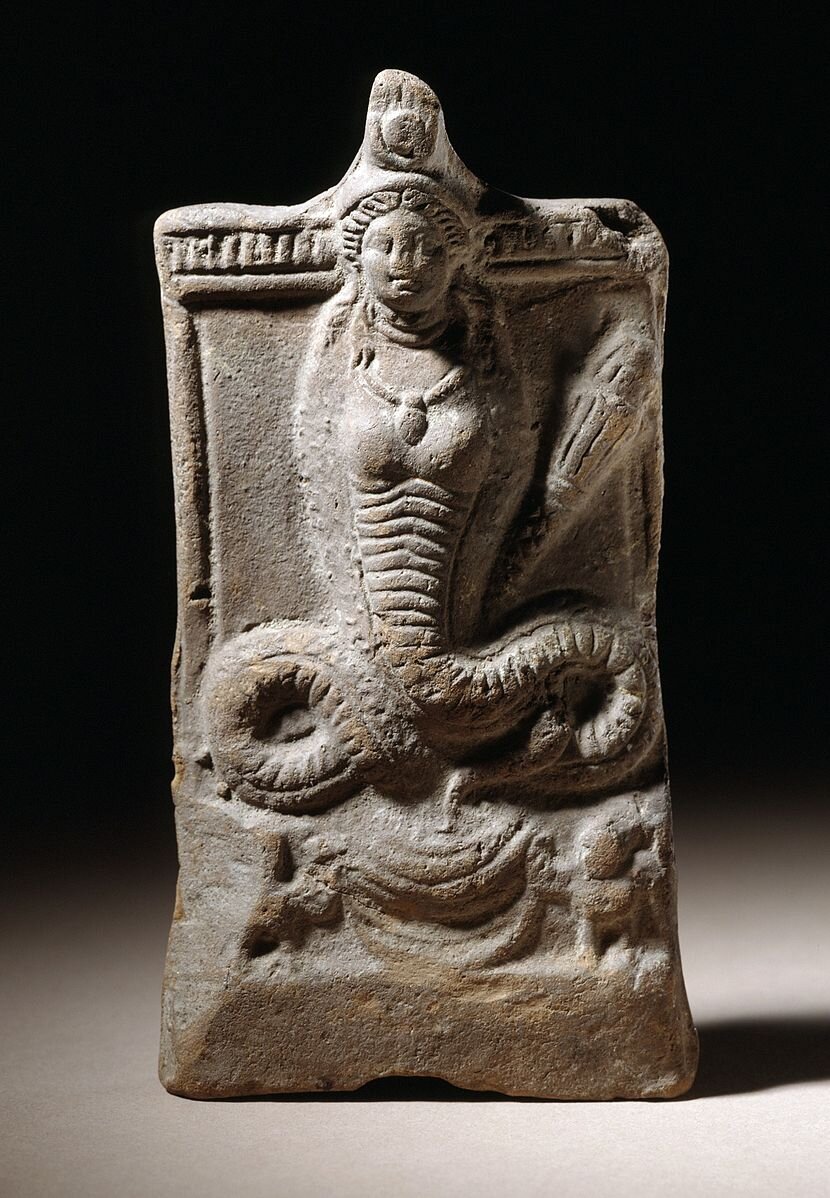
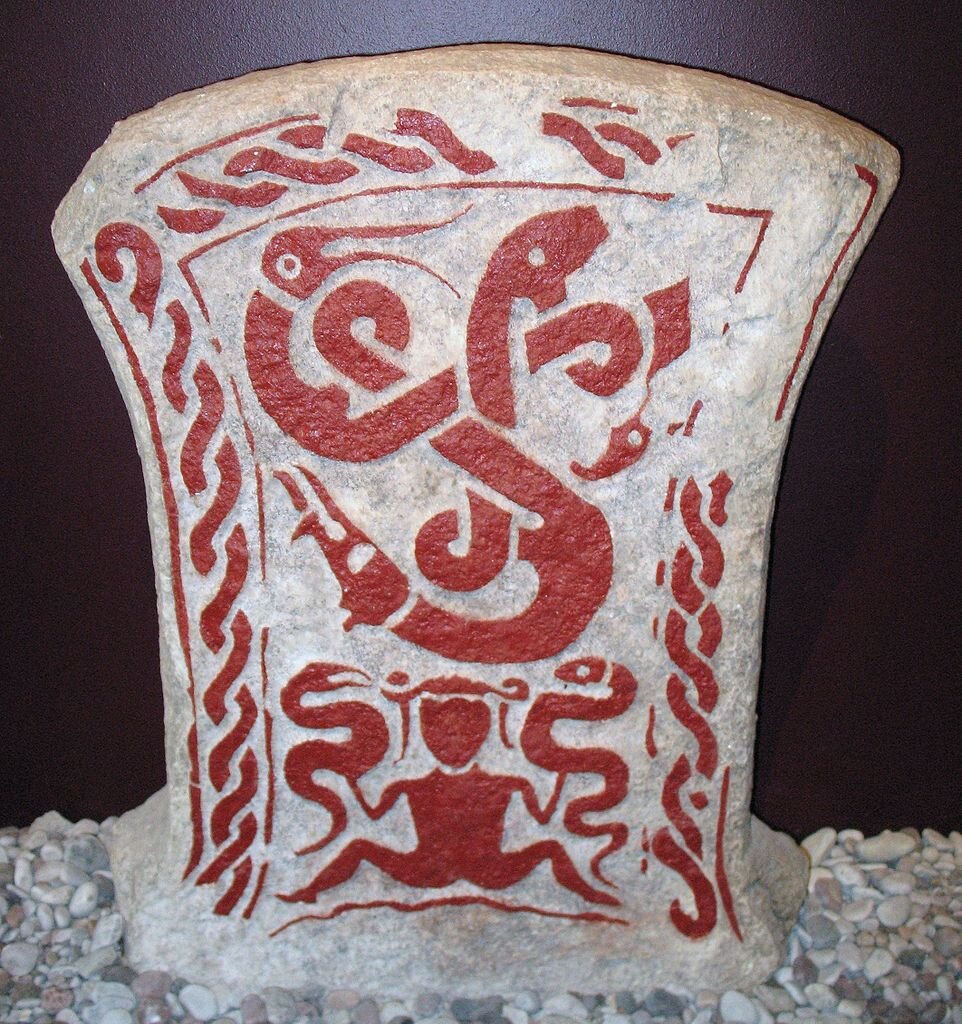
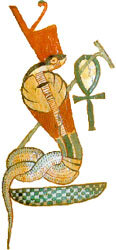
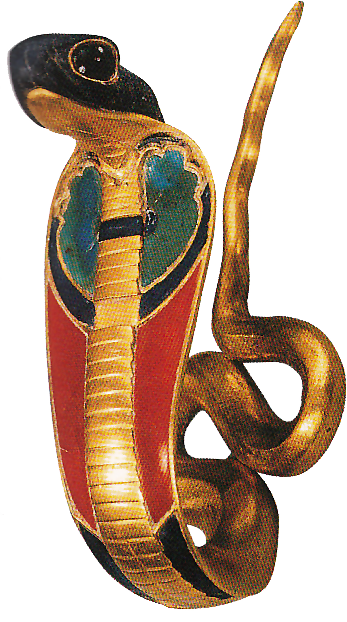
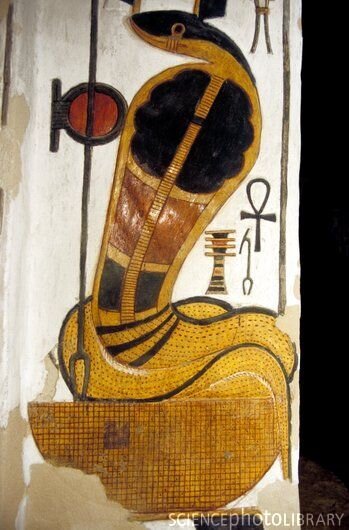


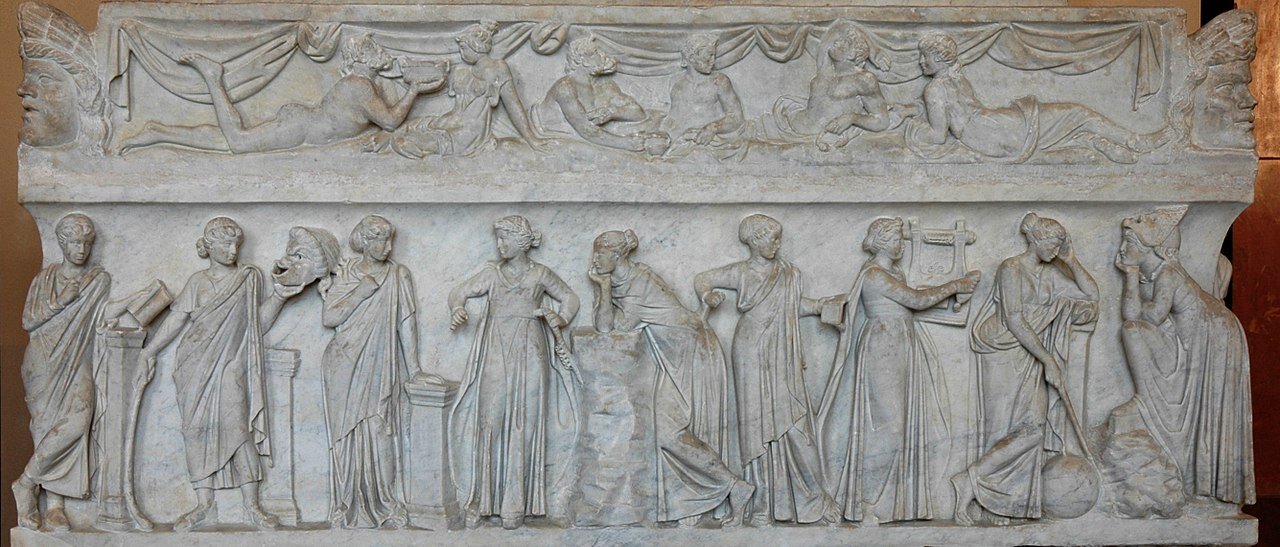


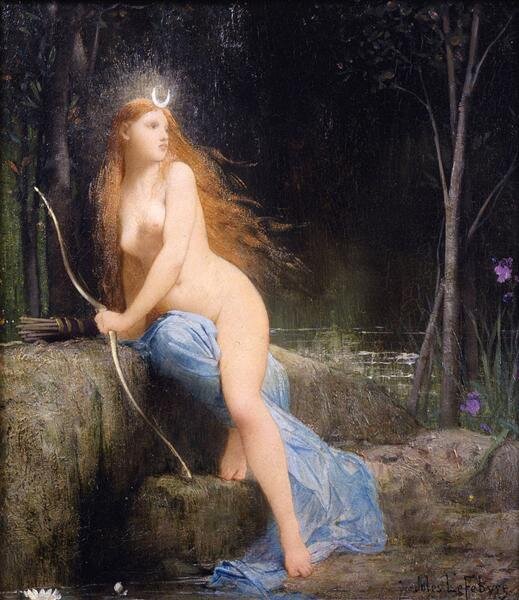












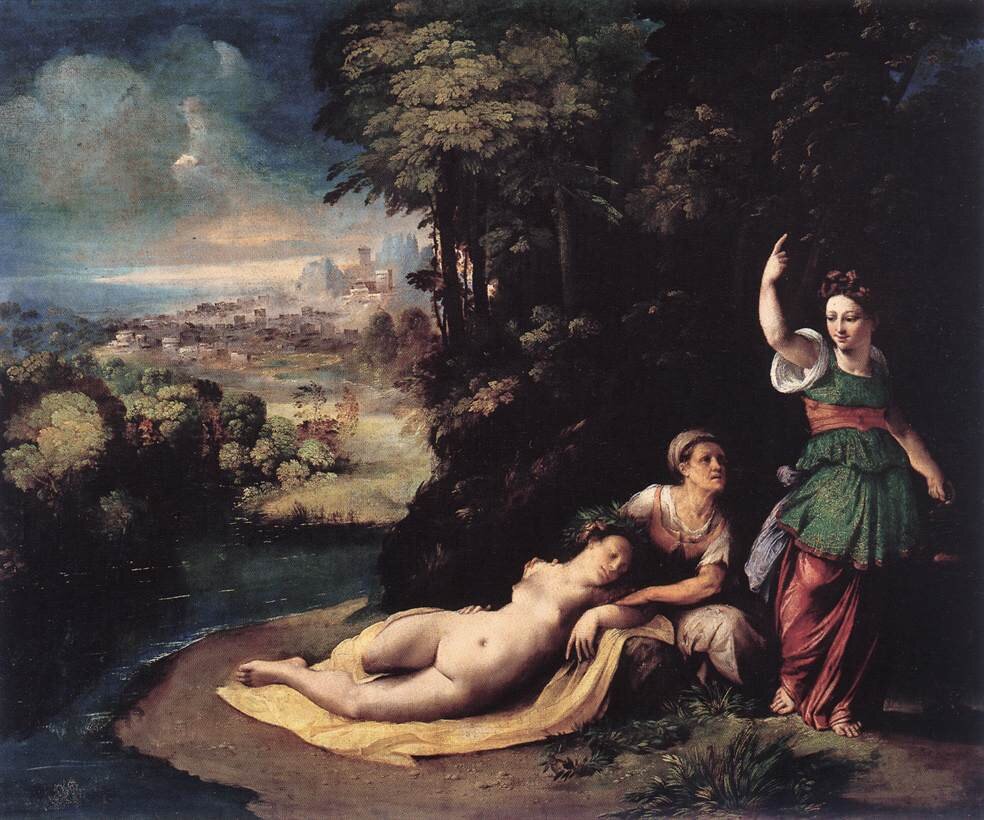
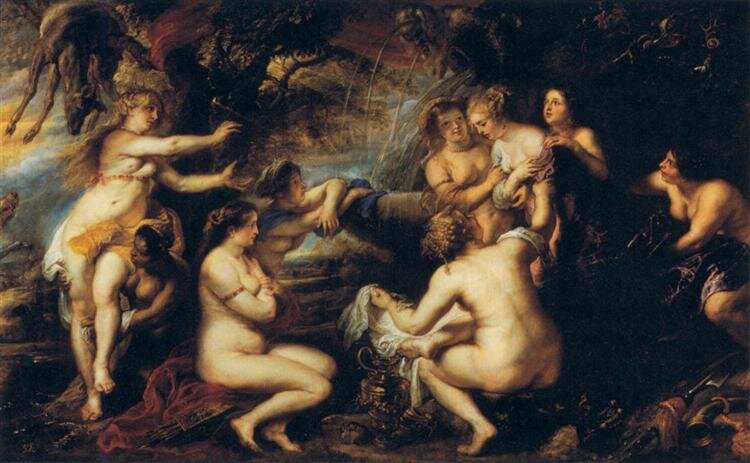

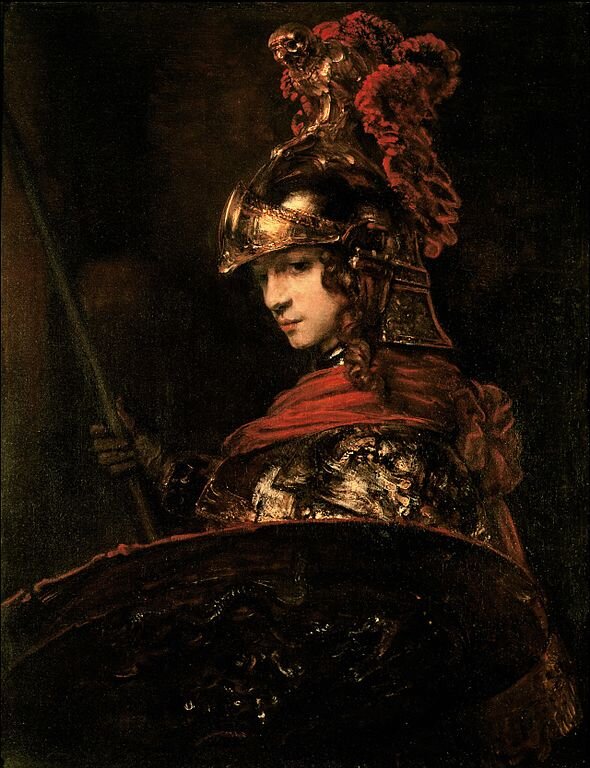
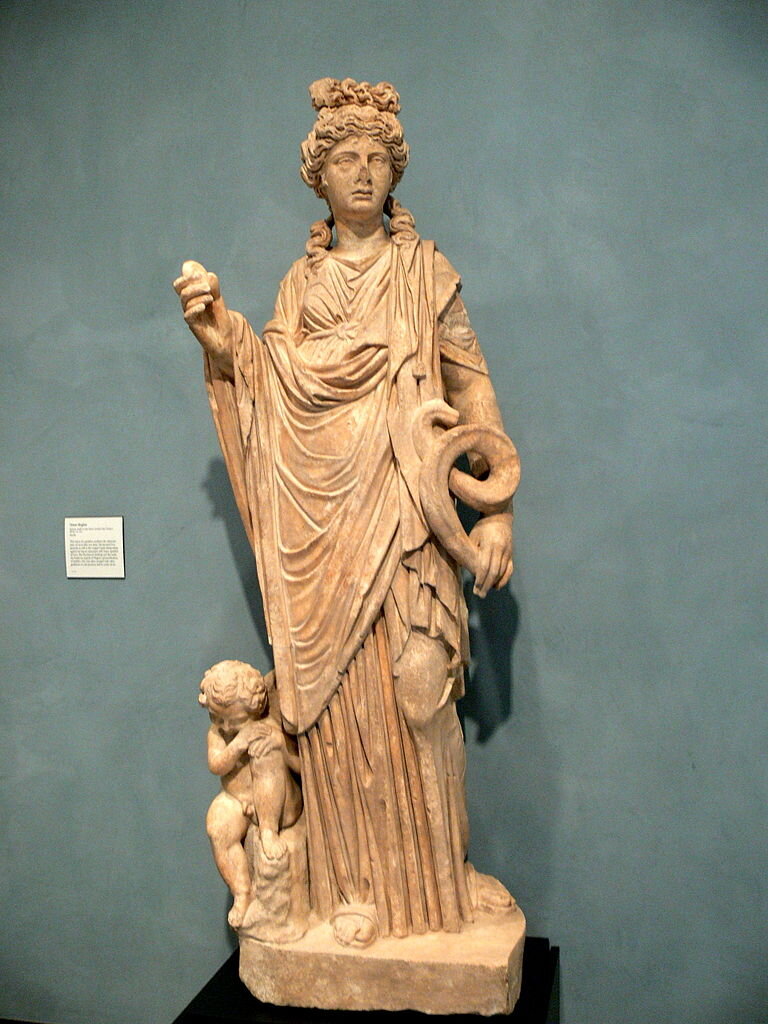



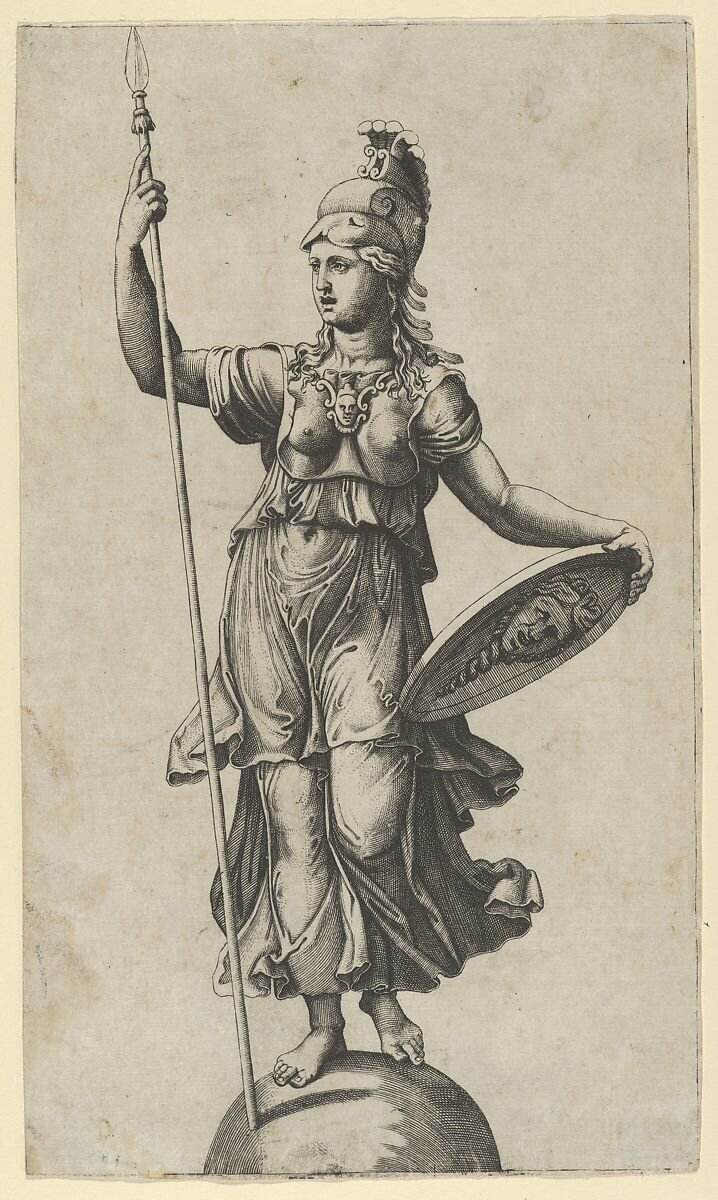

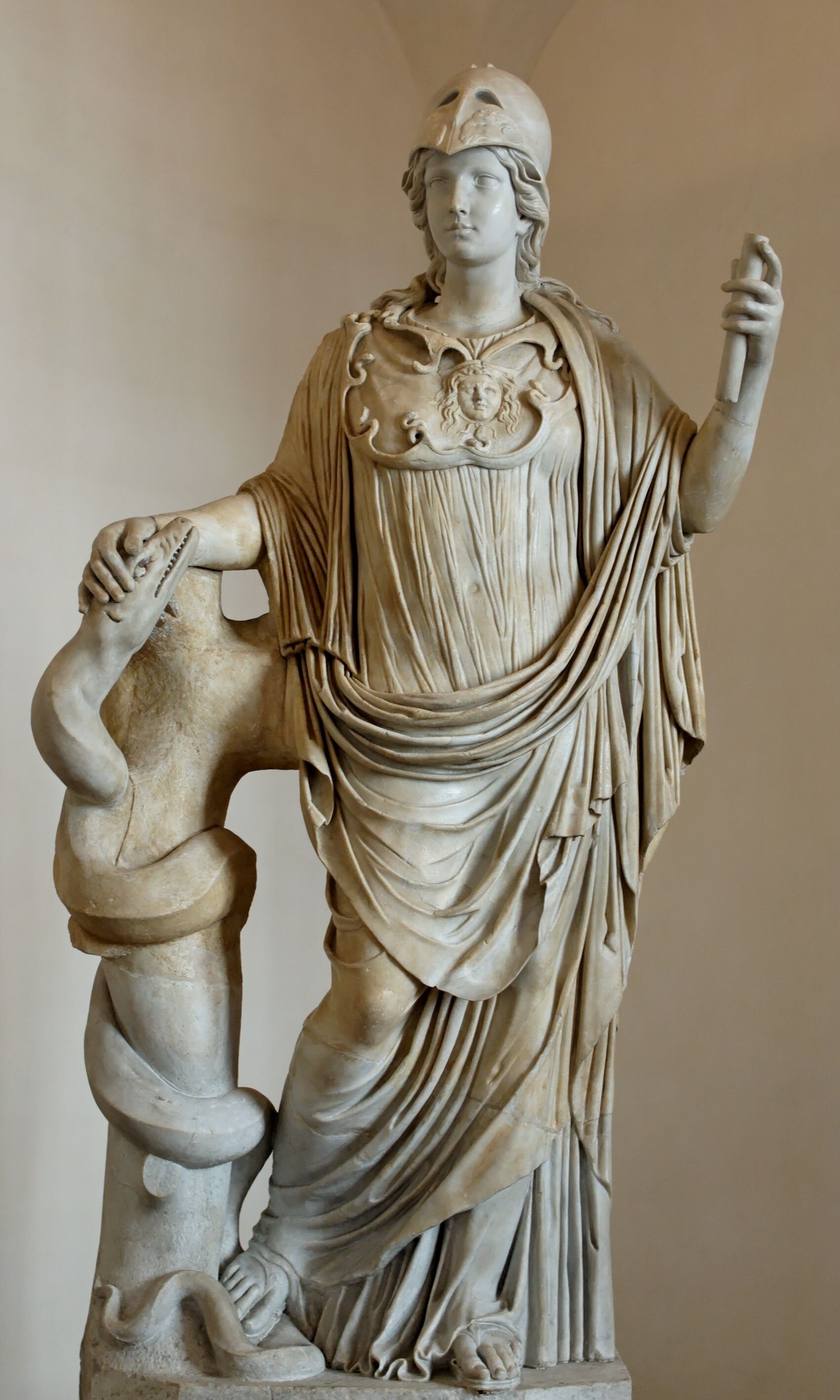



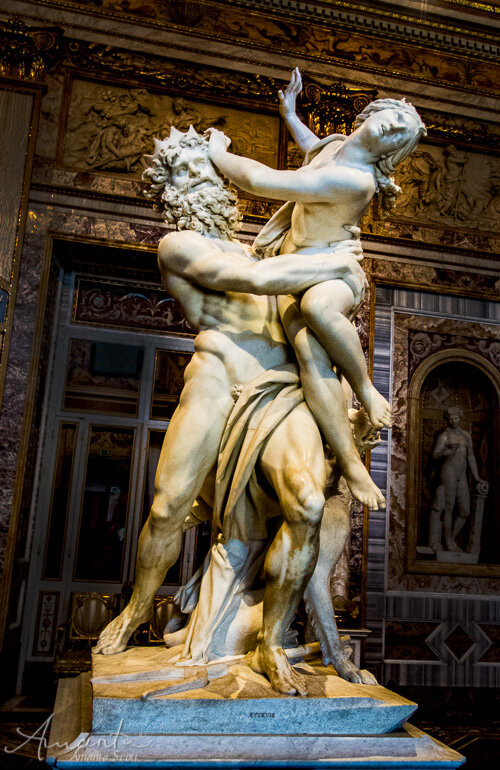

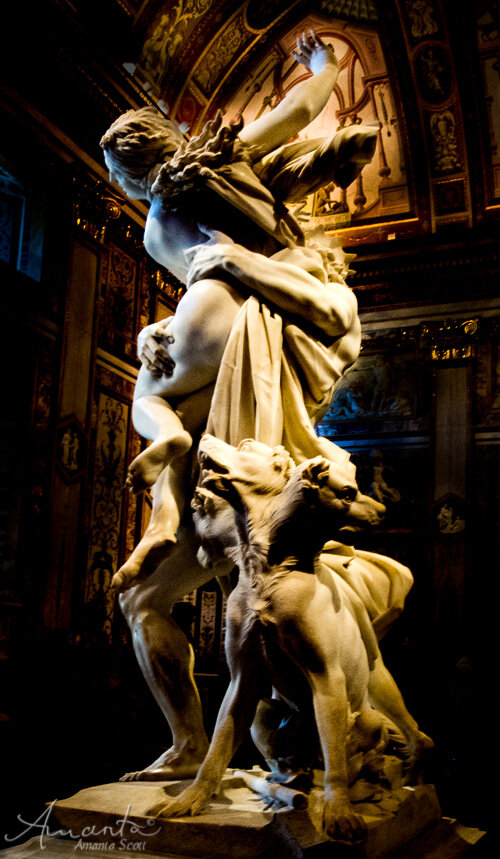





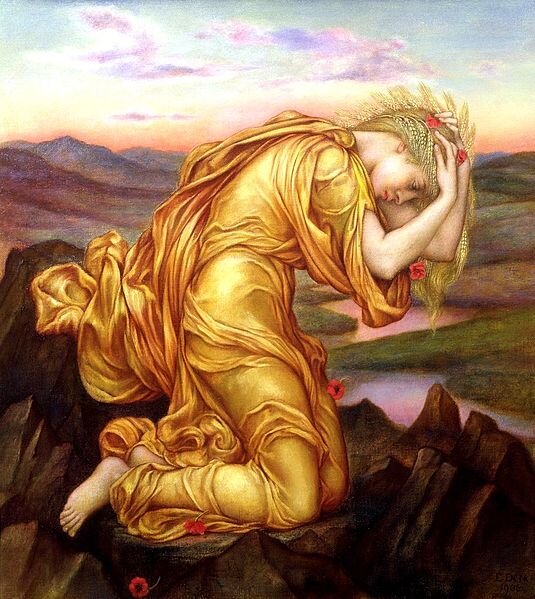


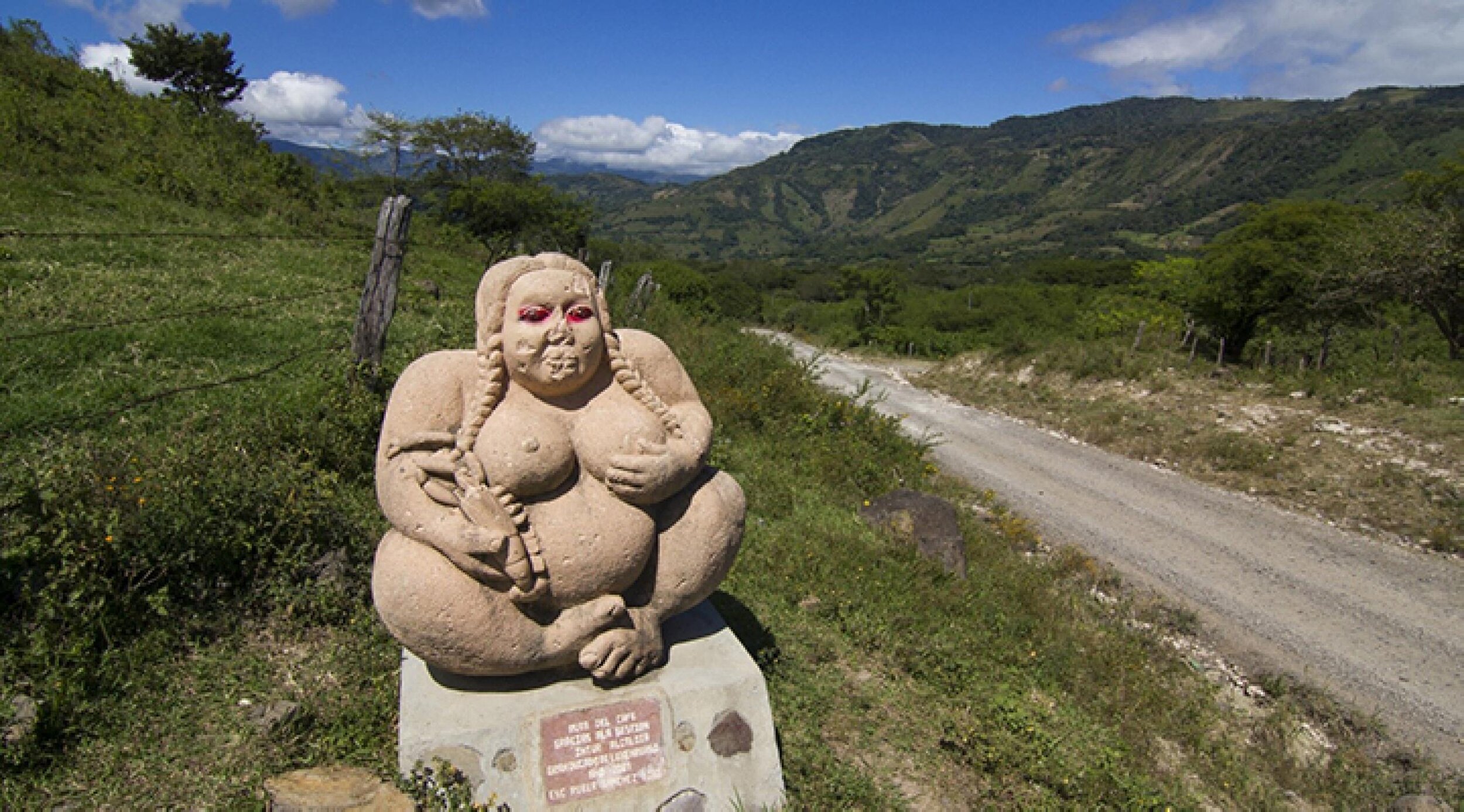












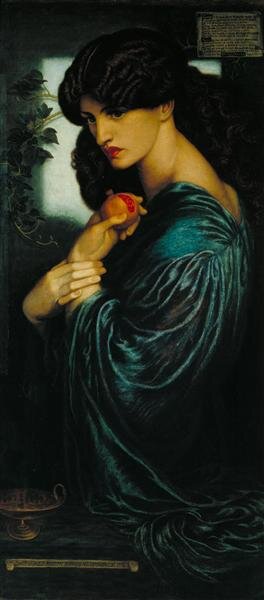
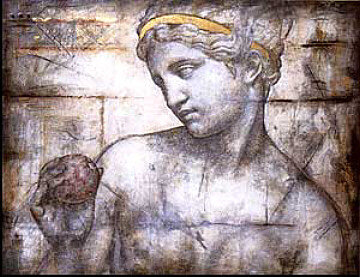








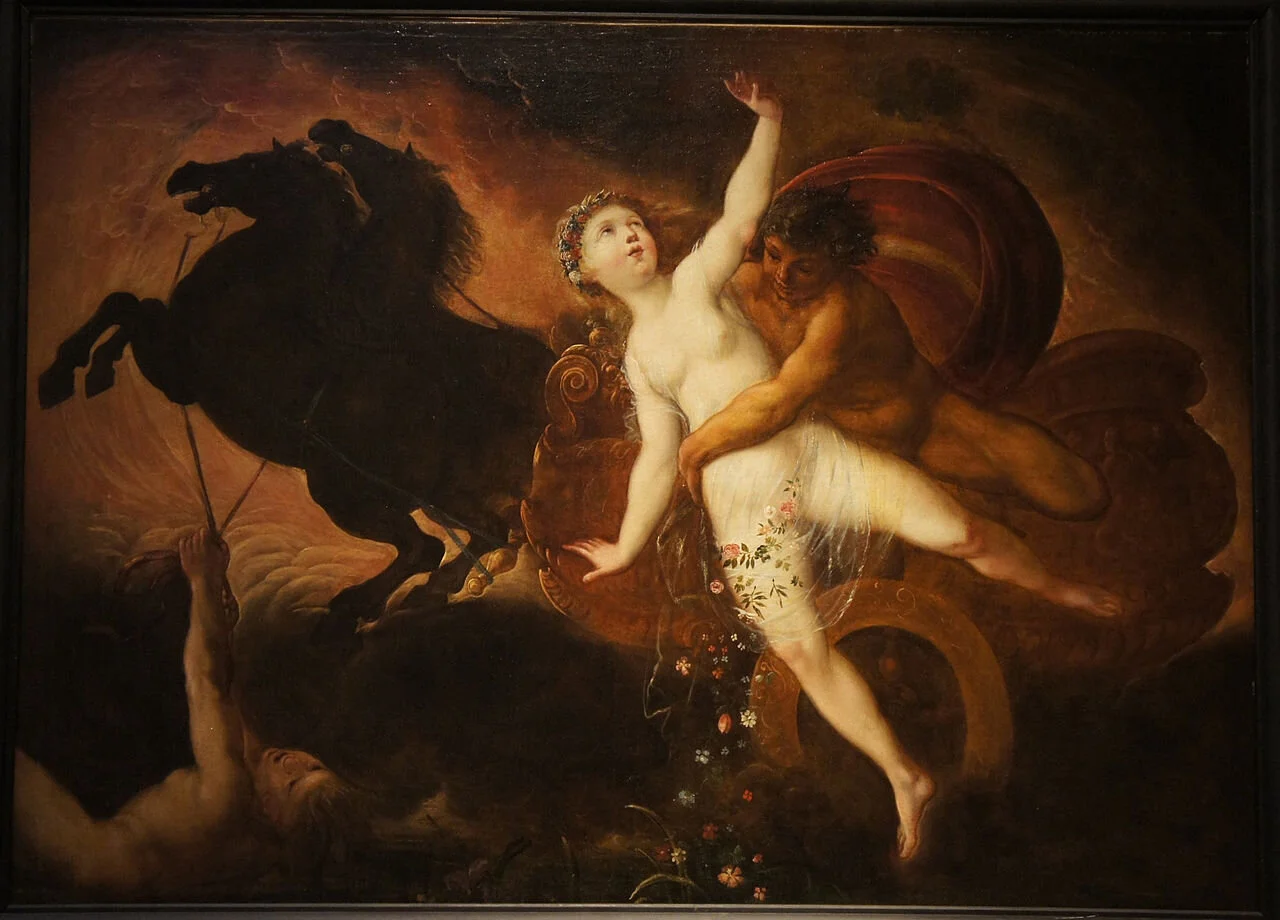



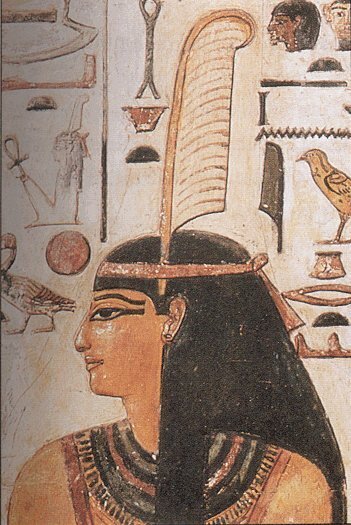



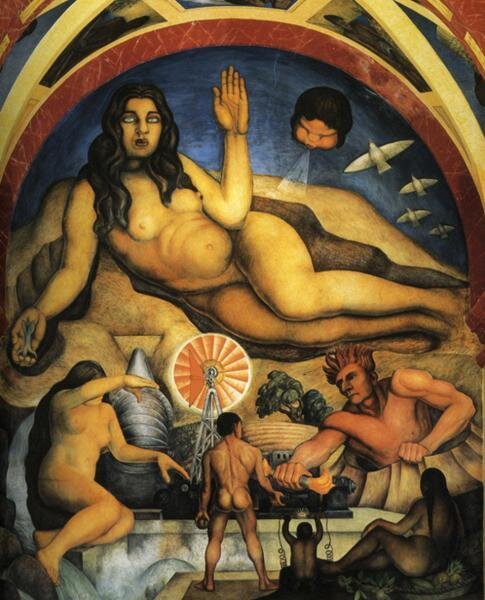
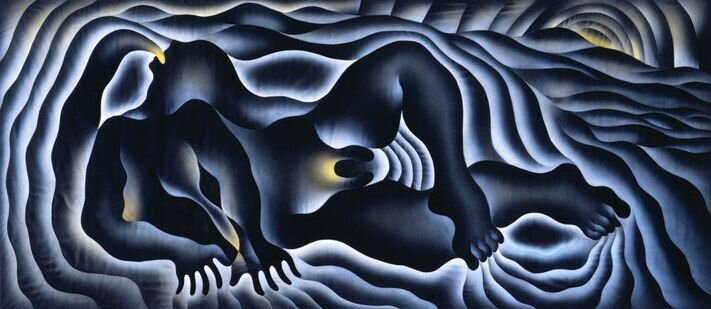

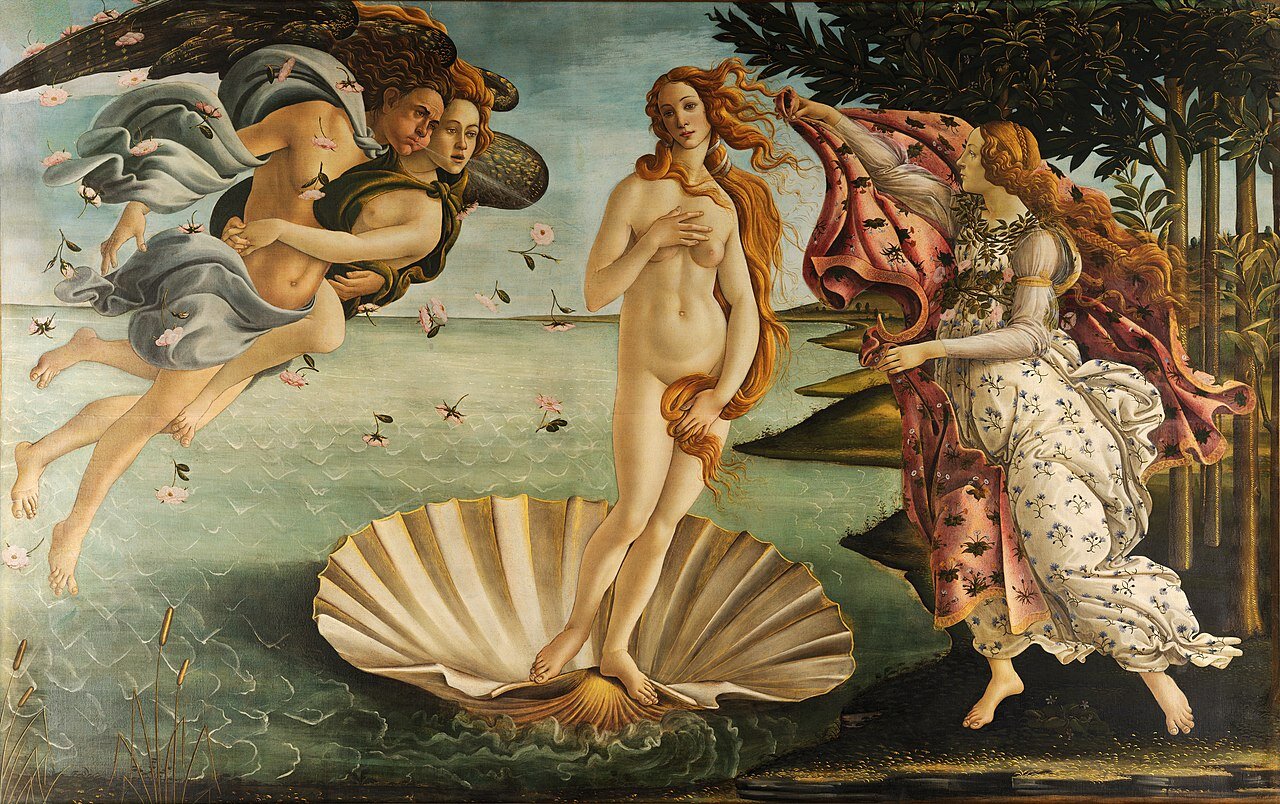








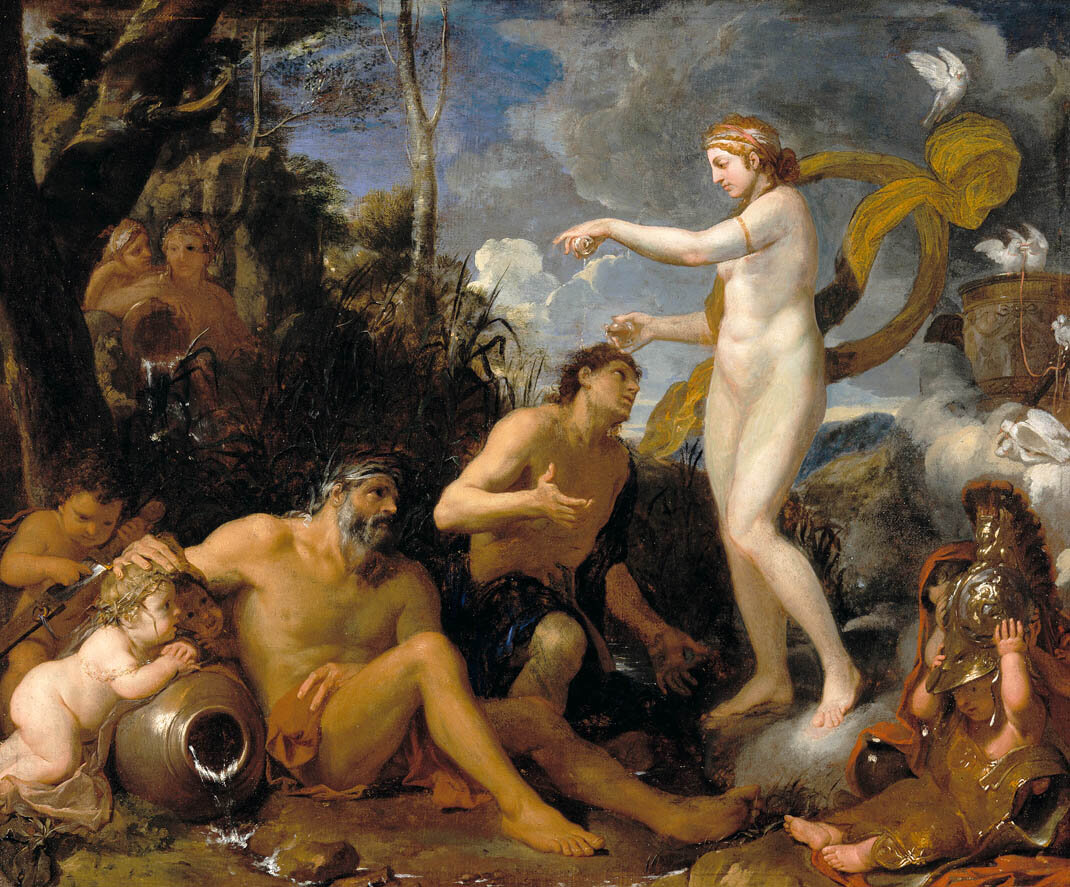


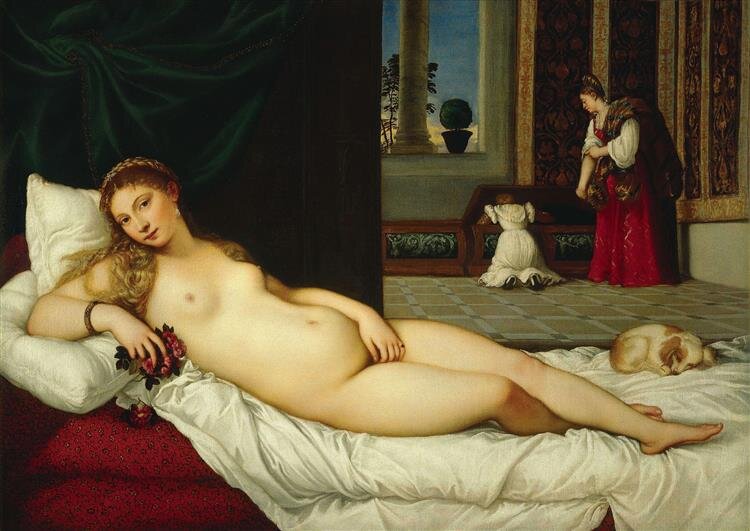
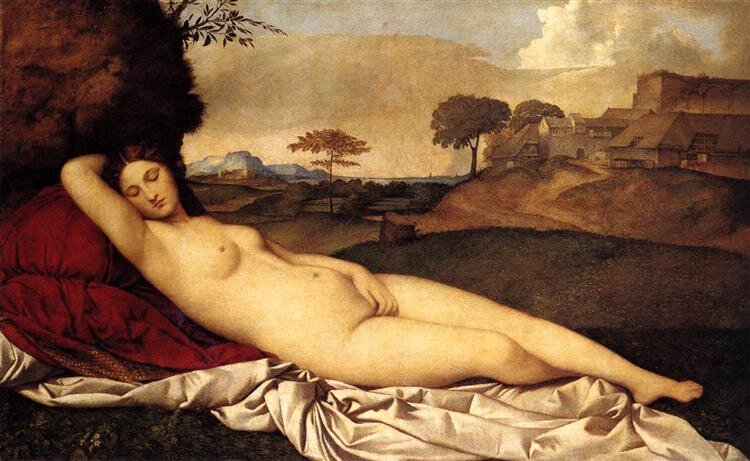

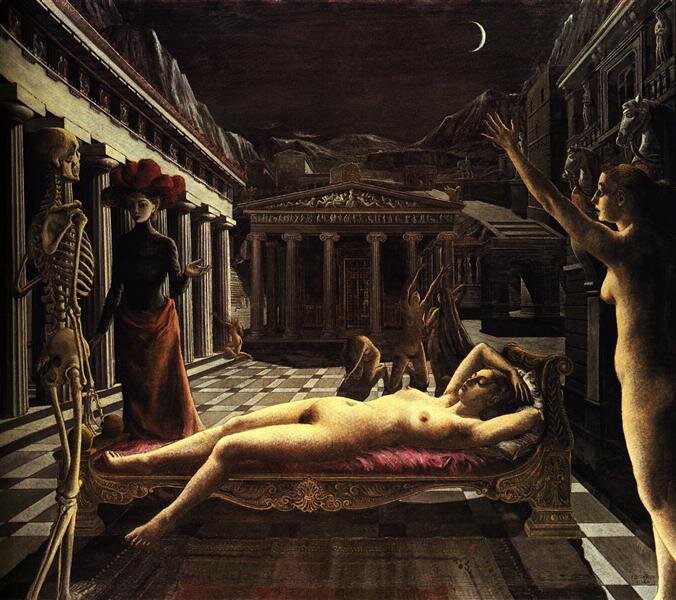
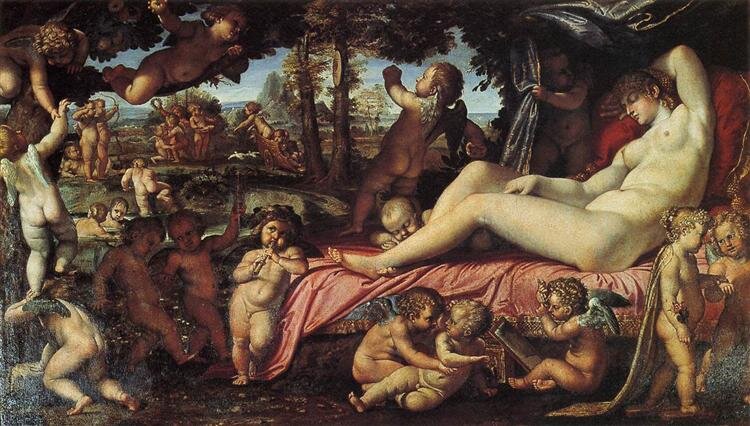
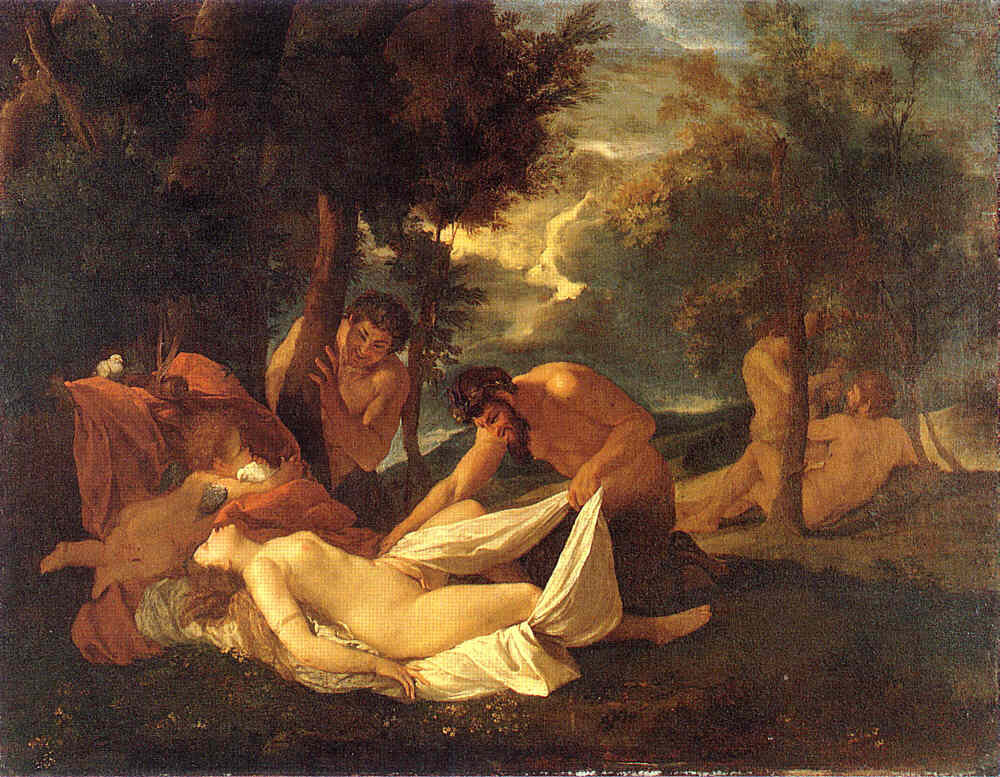
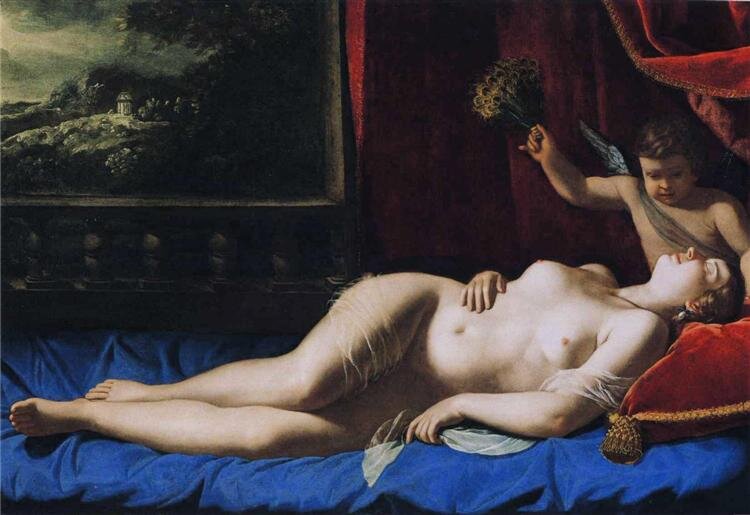
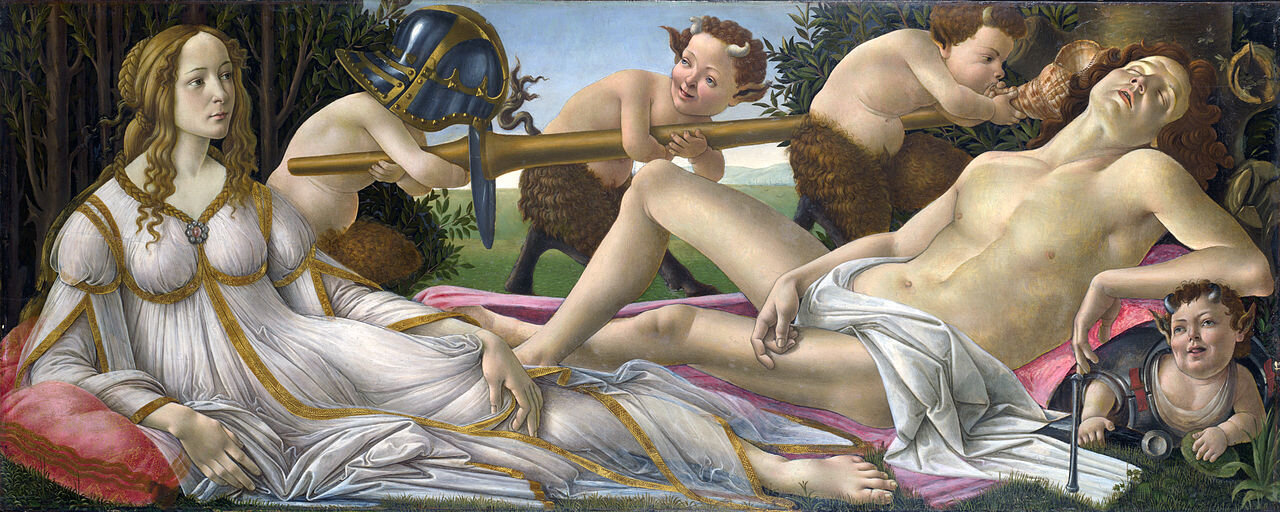







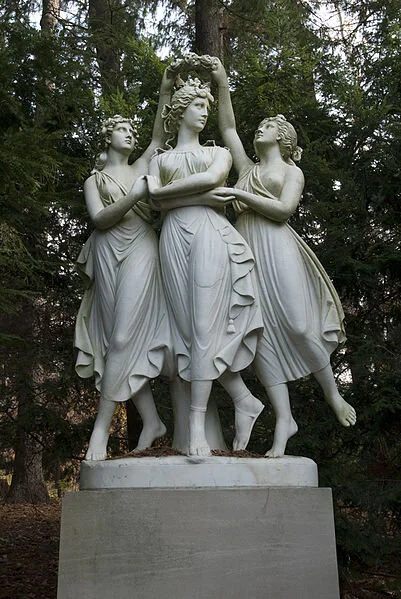
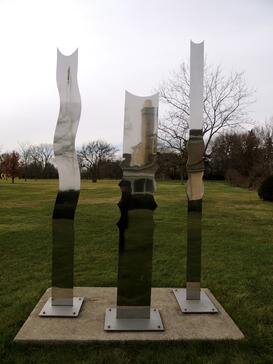















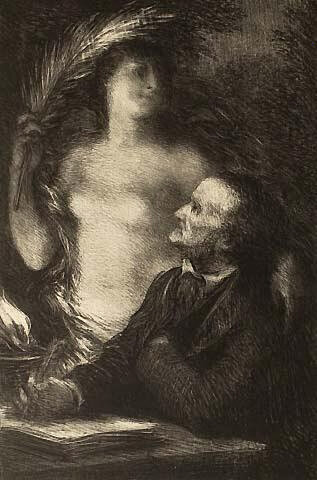


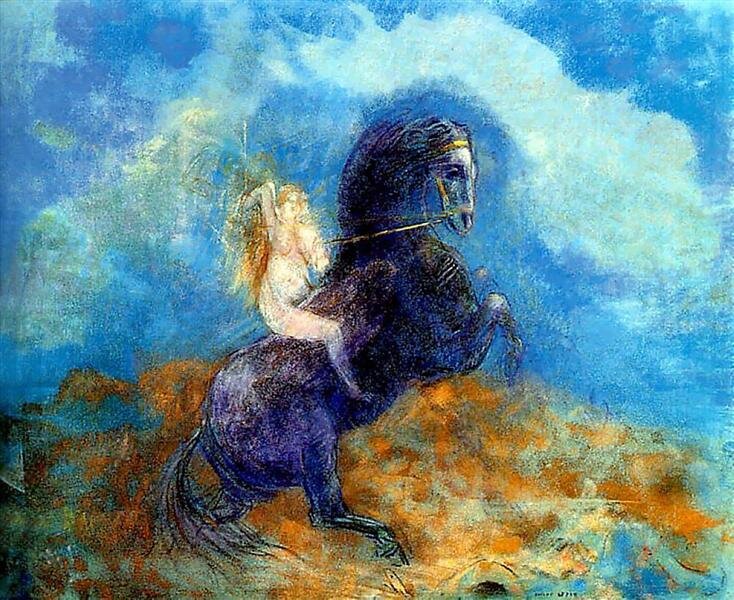
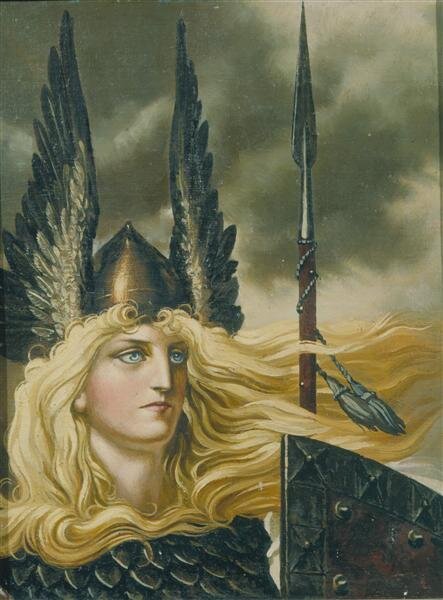
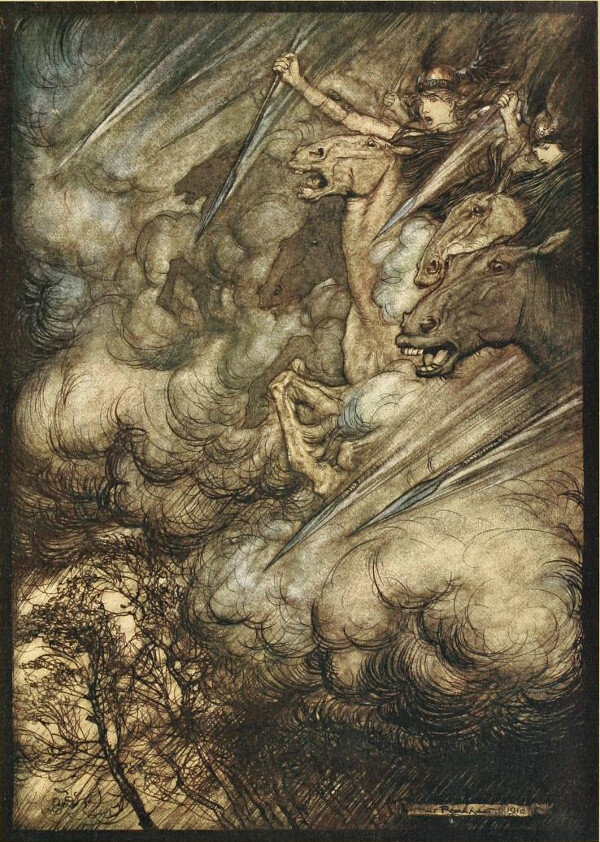


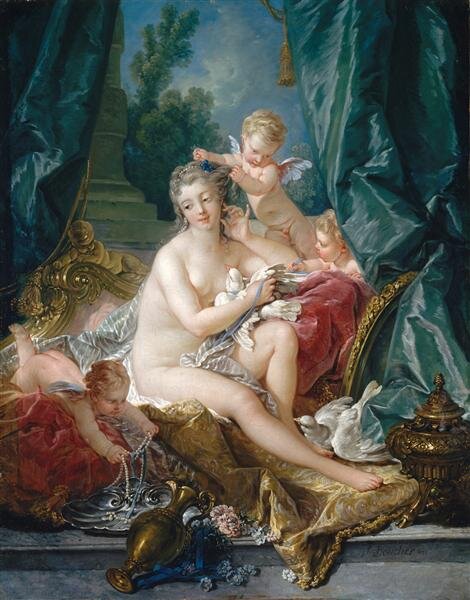

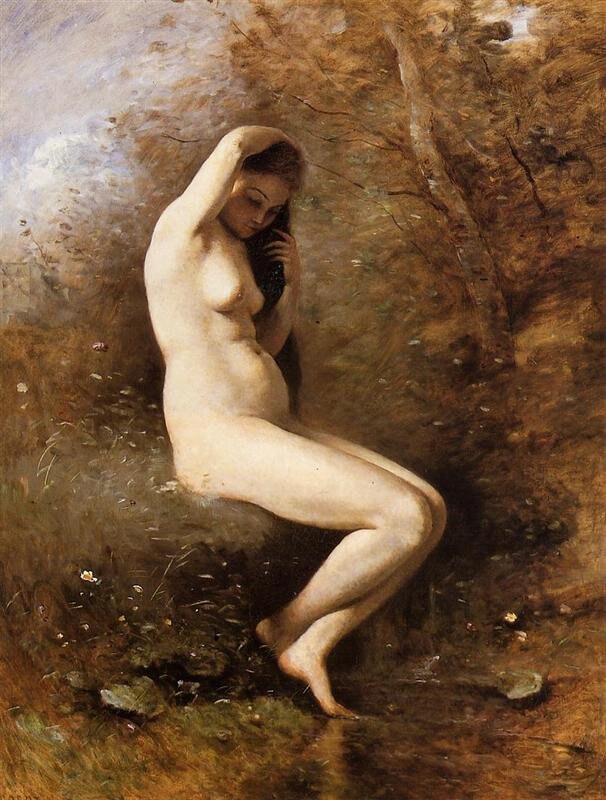

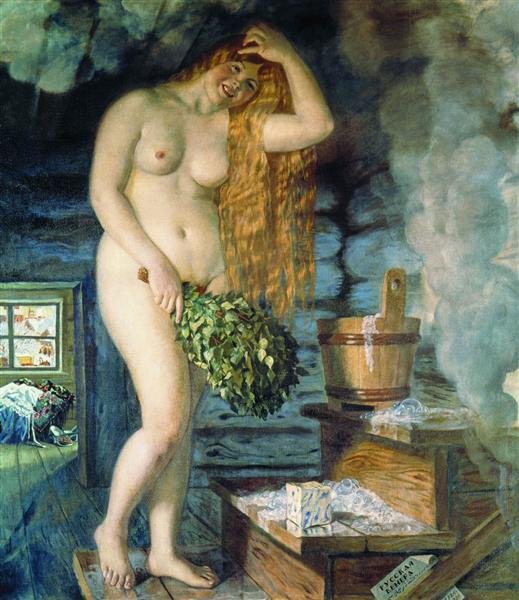
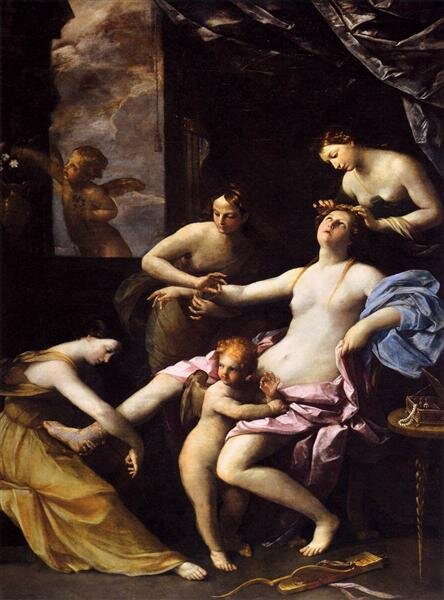
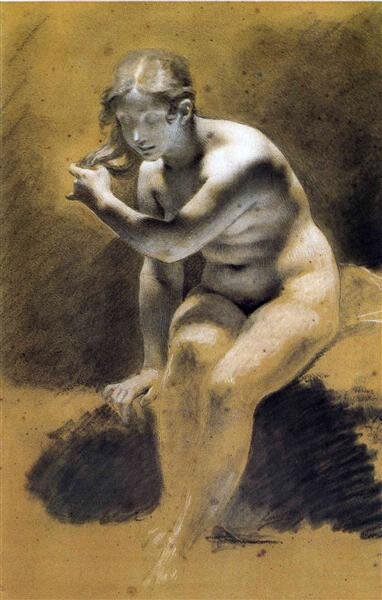
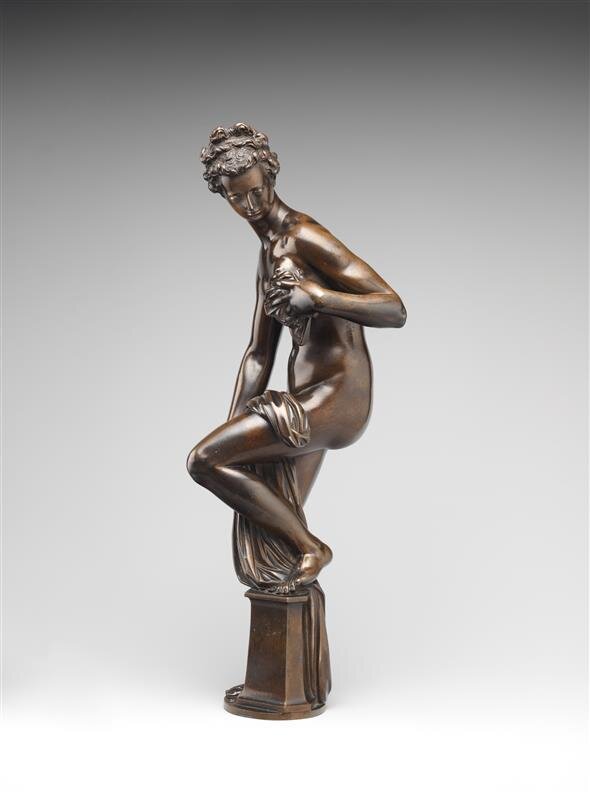









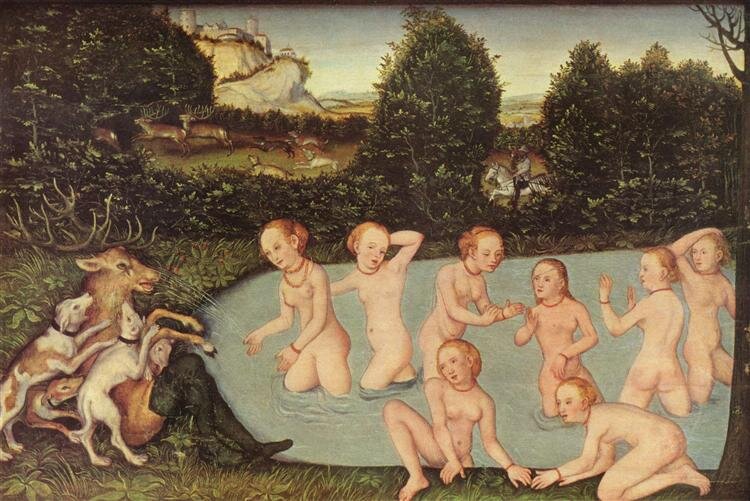
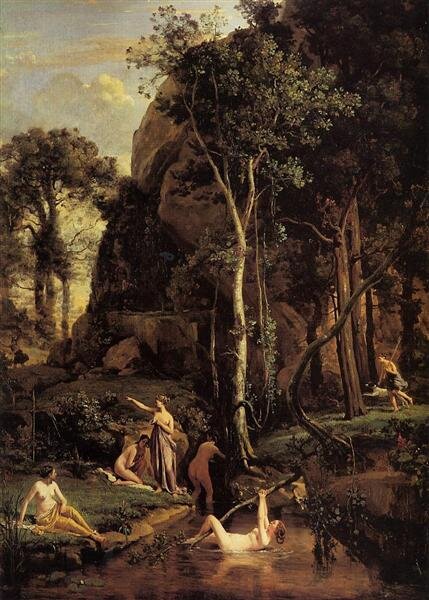
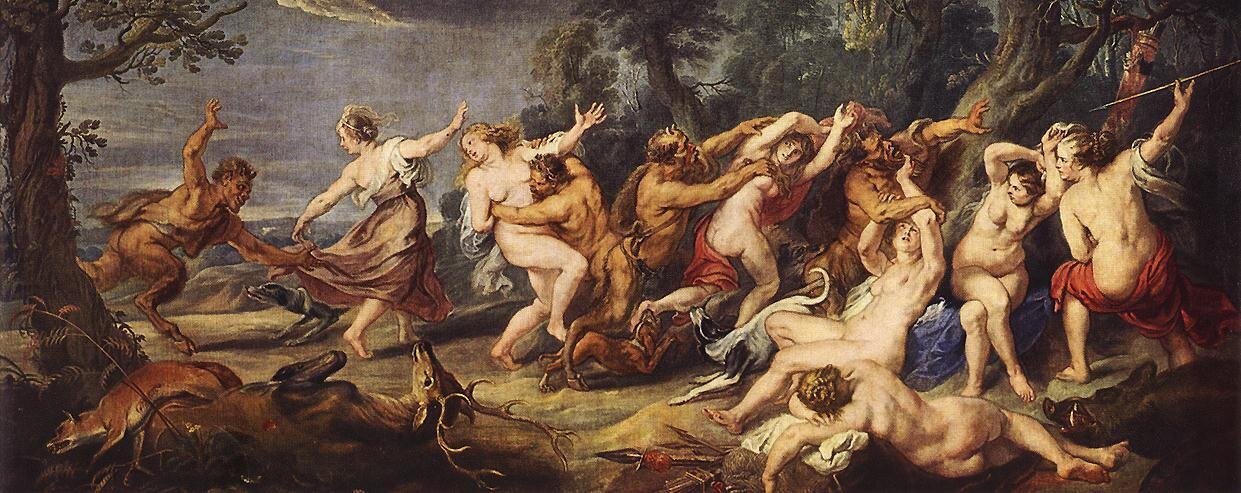
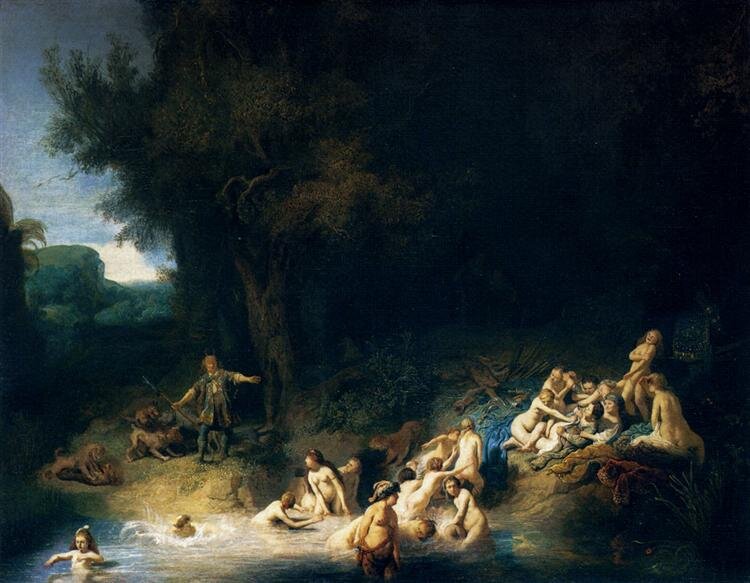
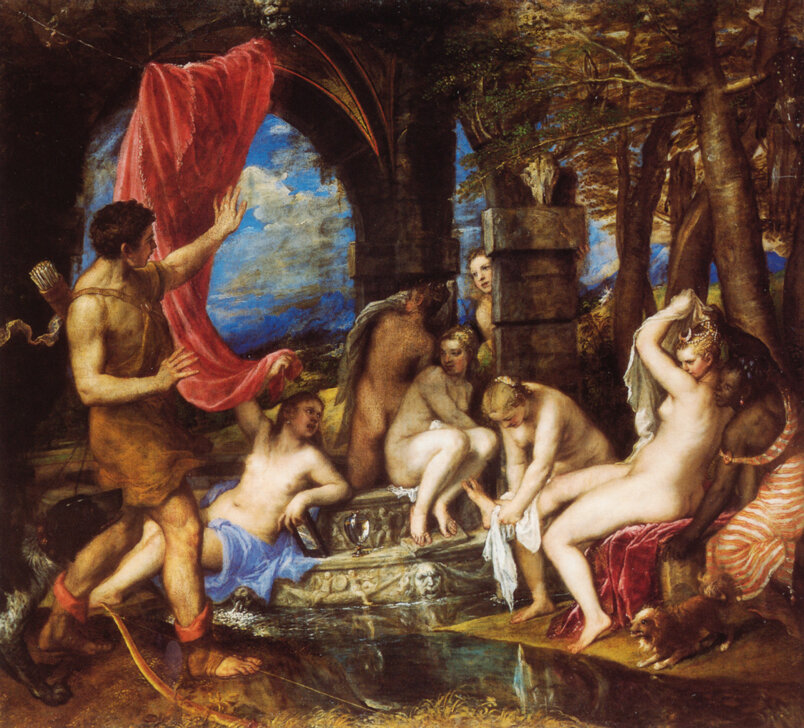
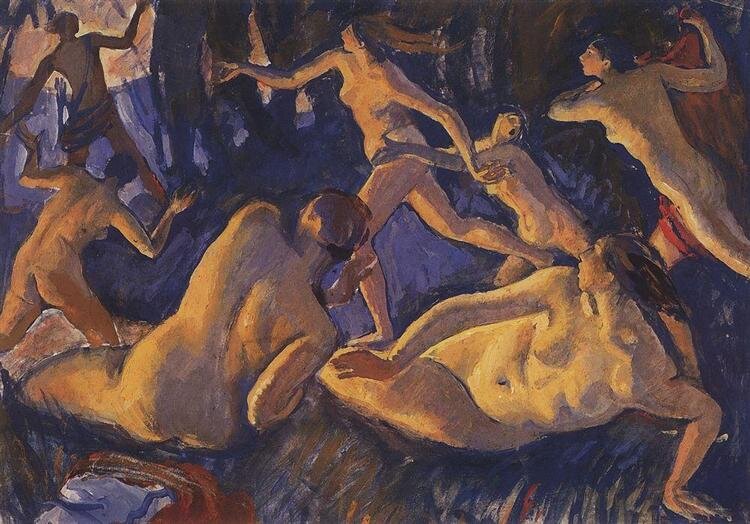

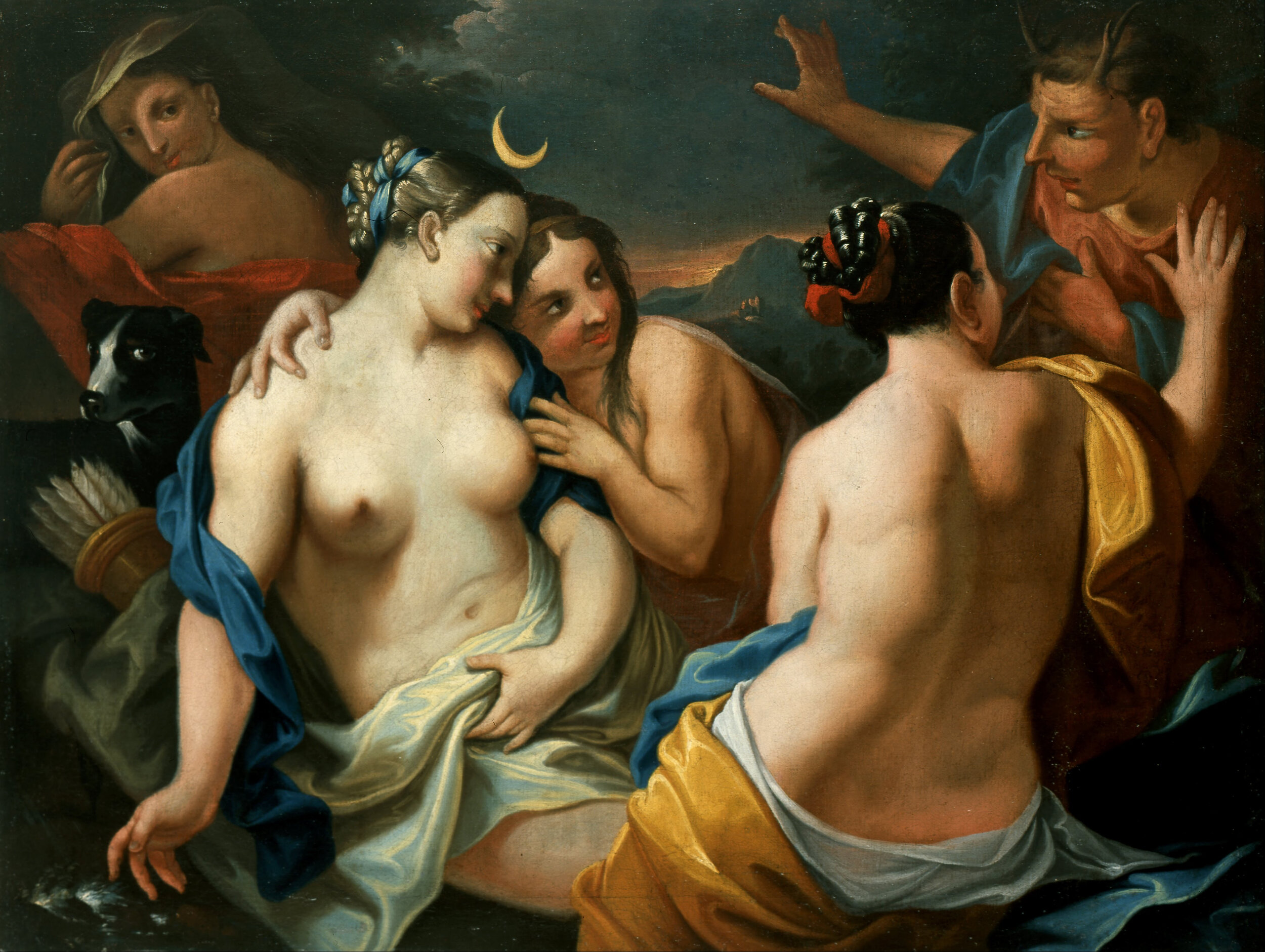
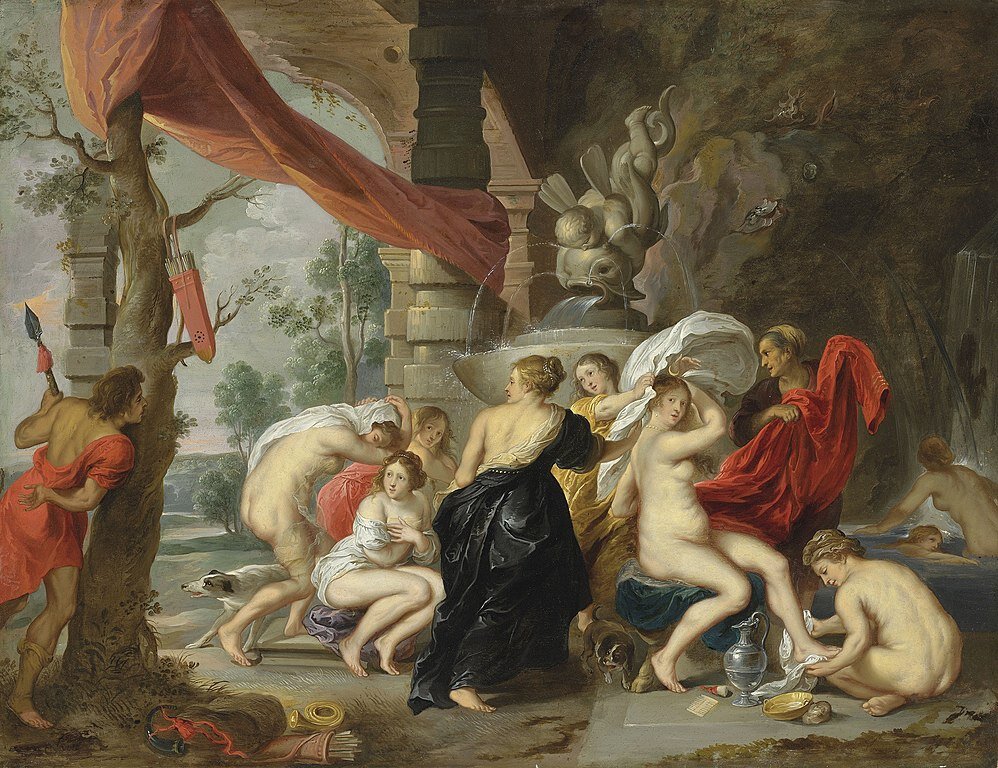








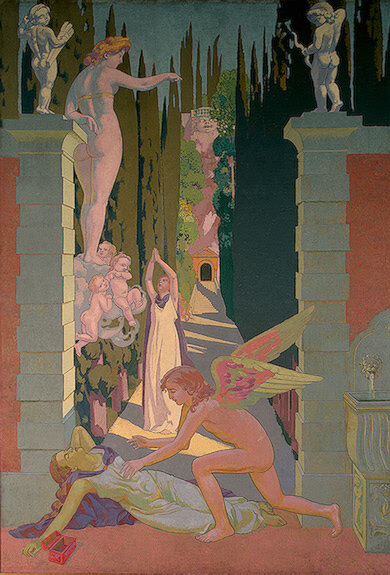
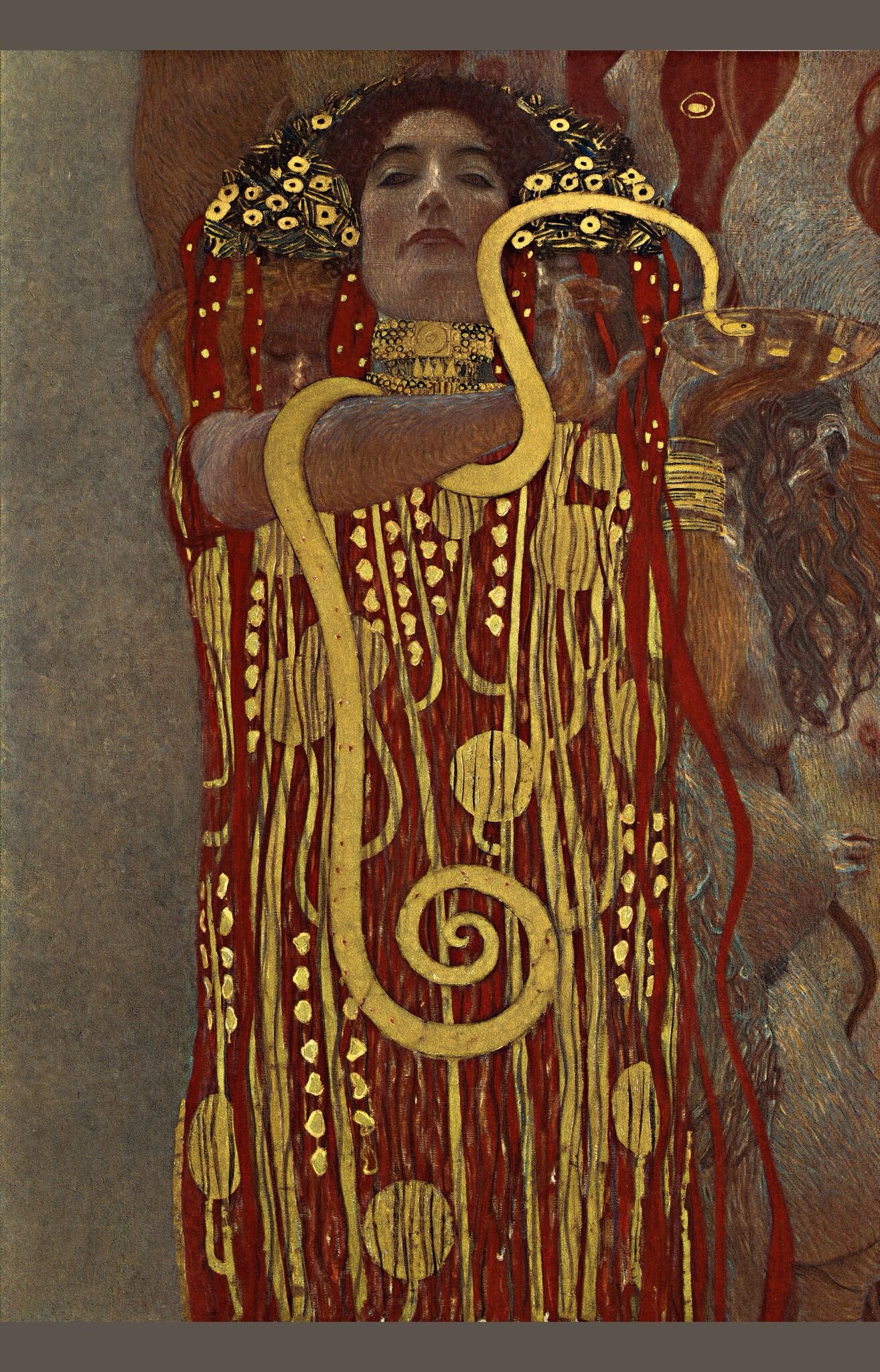
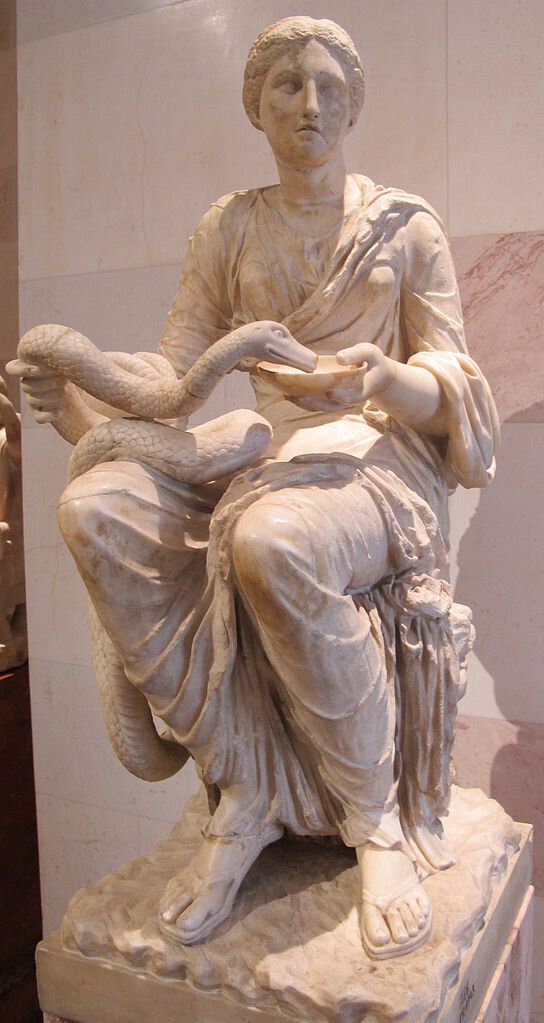
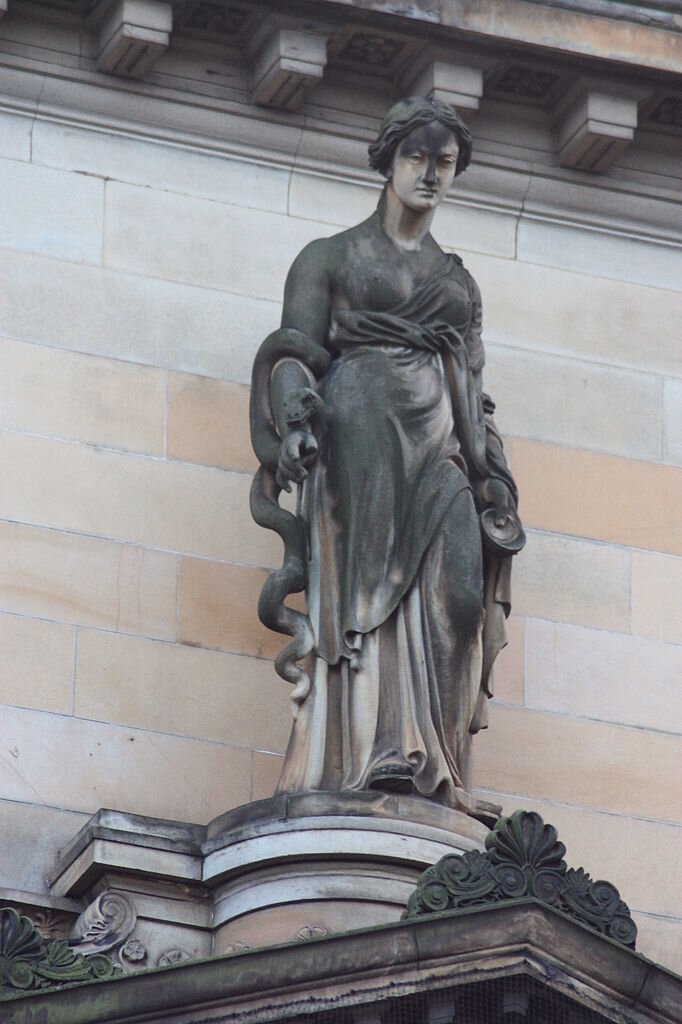
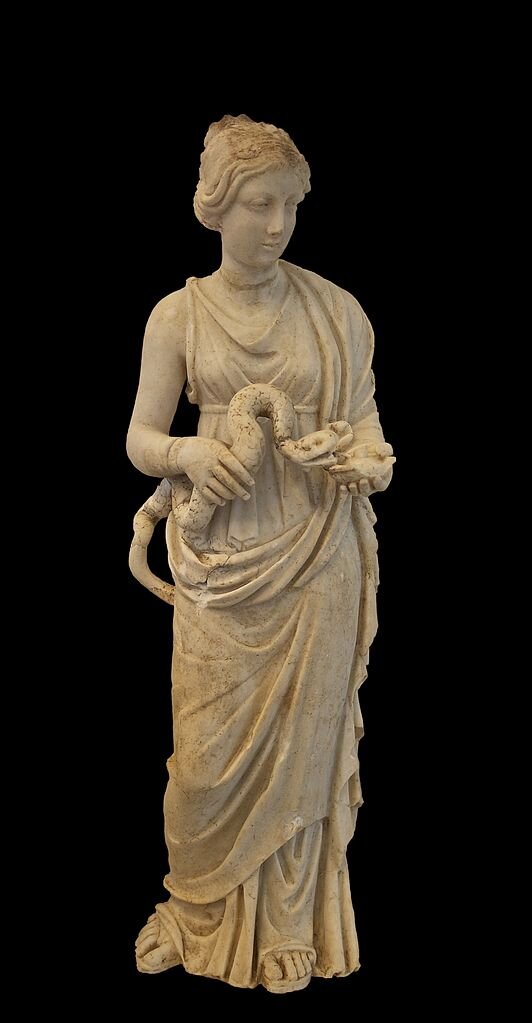
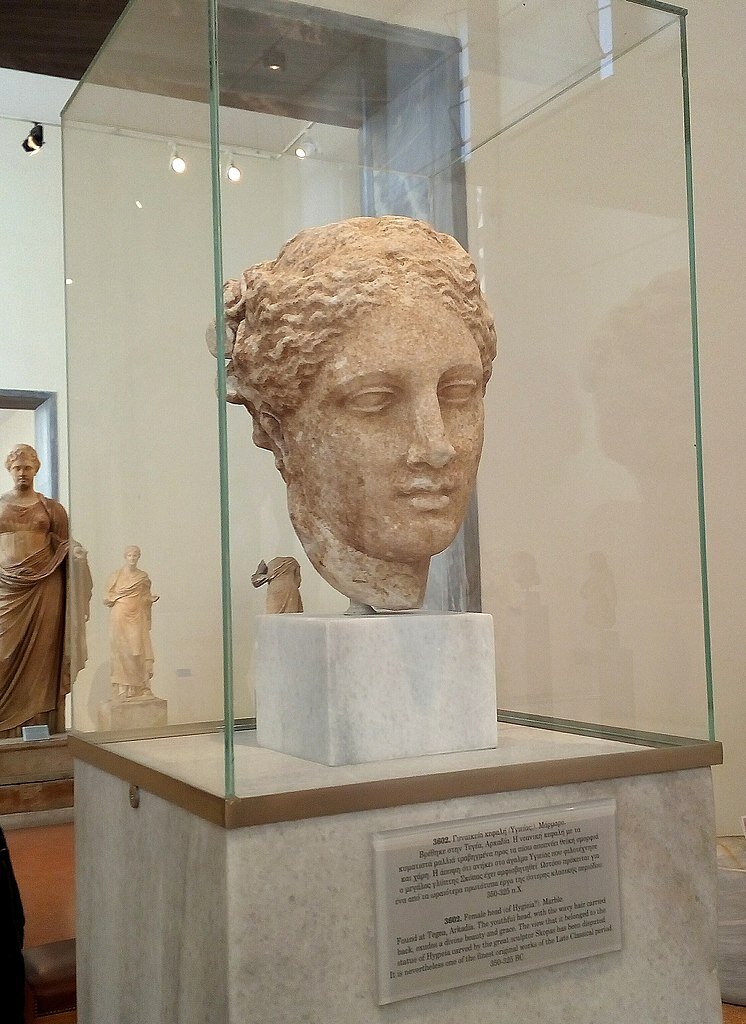
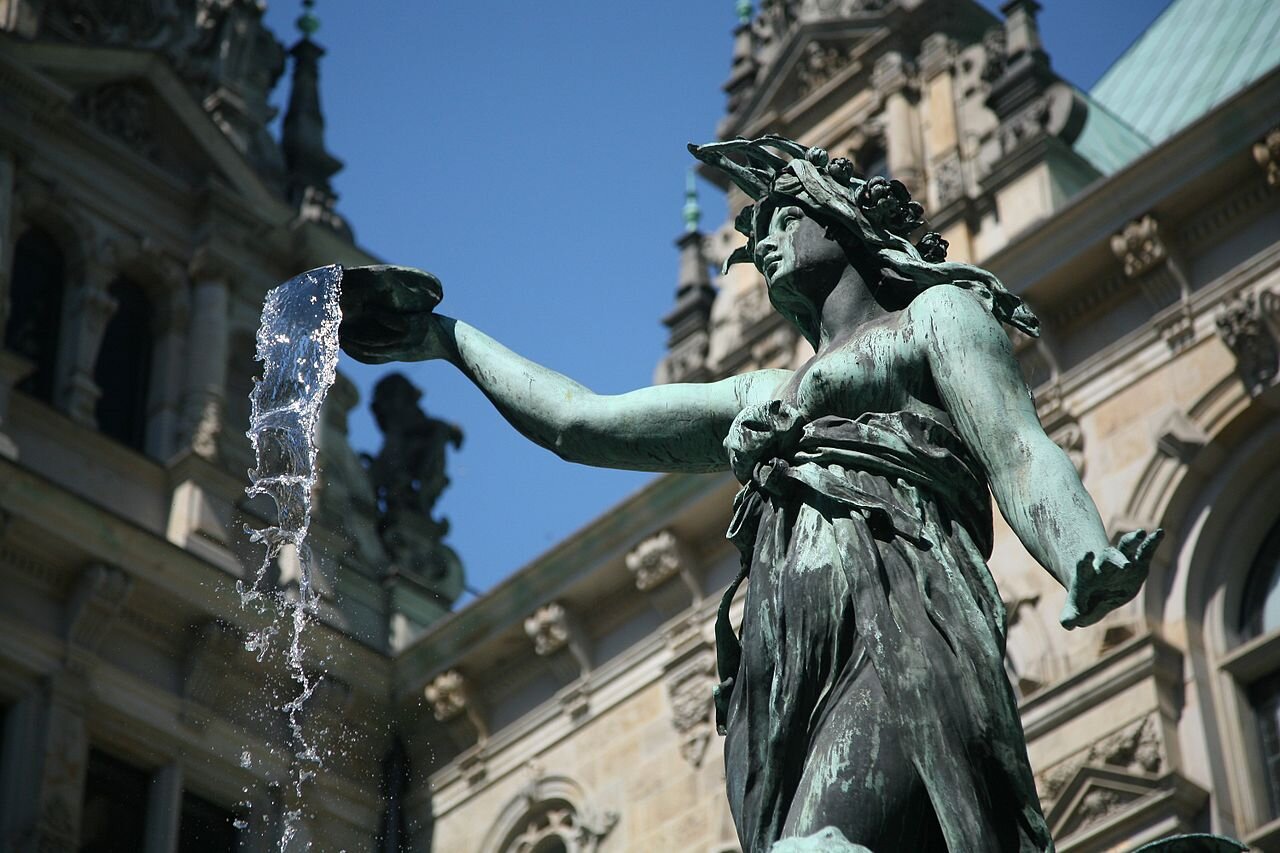
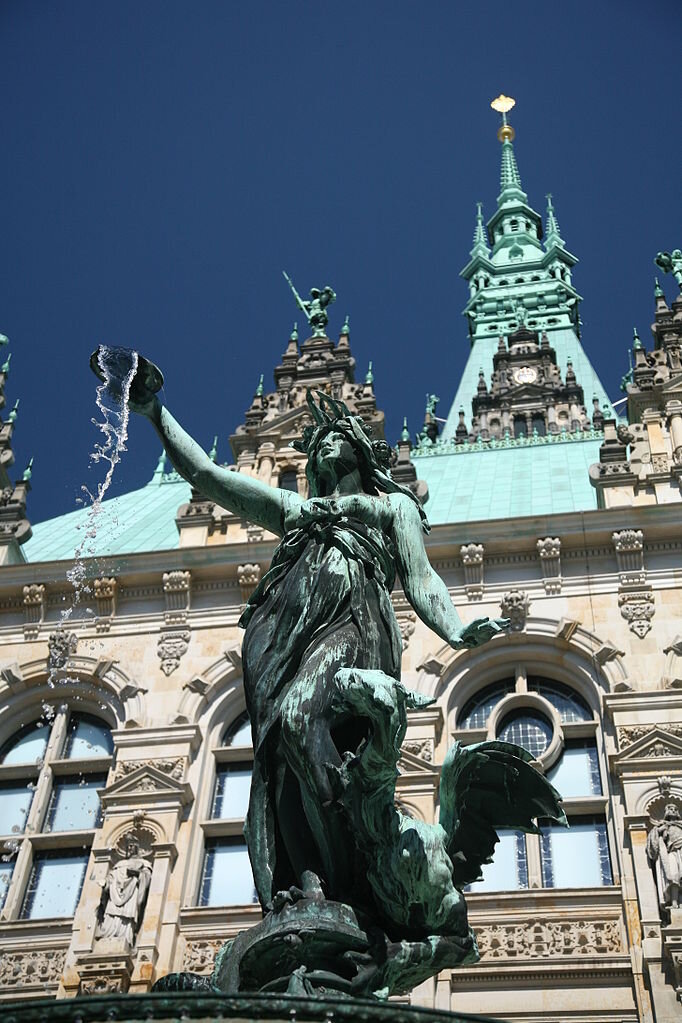

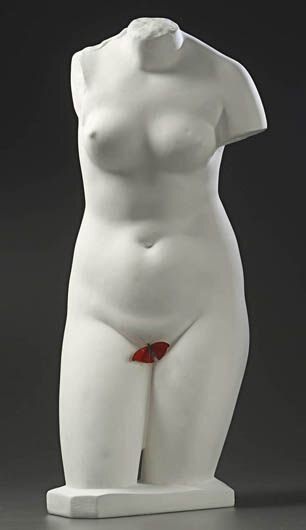


Egypt, 2nd century A.D., Los Angeles County Museum of Art, image via Wikimedia Commons courtesy of LACMA

Vitastjerna's dream from the Gutasaga with the three entwined snakes symbolizing Graip, Gute and Gunfjaun, with her at the bottom, Gotland, Sweden. Now in Fornsalen museum, Visby.

Buto, Cobra Goddess of Lower Egypt (also known as Ua Zit, Uatchit, Udjat, Wadjet, Wadjit, Edjo). She was portrayed as the Uranus cobra worn on the Pharaoh’s brow.
image from Egyptianmyths.net

(painting from the tomb of Nefertari, ca 1270 BC)
image from ferrebeekeeper.wordpress.com

Sarcophagus known as the "Muses Sarcophagus", representing the nine Muses and their attributes. Marble, first half of the 2nd century AD, found by the Via Ostiense, Louvre Museum
image from Wikipedia

1800s, Cleveland Museum of Art
An adaptation of the Greek goddess Diana or Roman goddess Artemis, goddess of the hunt, this winged fairy wears a British crown and a short skirt and carries a spear. Like Diana/Artemis, the stag is presented on her left. Her hair resembles that of other Hindu goddesses.

Marble by Bernardino Cametti, 1720. Pedestal by Pascal Latour, 1754. Bode Museum, Berlin., image via Wikipedia

Titian, 1556-1559, Kunsthistorisches Museum, Vienna, Austria, National Gallery, London, UK

Venus-Hygieia. Roman, made in Asia Minor, about A.D.200, Getty Villa
image from Wikipedia

Pallas Athena standing on a globe, a spear in her left hand, a shield in her right
Marcantonio Raimondi, ca. 1520–27, Metropolitan Museum of Art, The Elisha Whittelsey Collection, The Elisha Whittelsey Fund, 1949

Detail from the statue of the "Piraeus Athena" in the Archaeological Museum of Piraeus (Athens). The work has been given to either Kephisodotos or Euphranor (4th century B.C.), or deemed to be a Hellenistic-era creation in classicizing style. Picture by Giovanni Dall'Orto, November 14 2009.

Gian Lorenzo Bernini, 1621-1622, Galleria Borghese, Rome, Italy, photo by Amanta Scott

Gian Lorenzo Bernini, 1621-1622, Galleria Borghese, Rome, Italy, photo: Amanta Scott

Gian Lorenzo Bernini, 1621-1622, Galleria Borghese, Rome, Italy, photo: Amanta Scott

Throning goddess, marble statue supposed to be Persephone, queen of the underworld, 480-460 BC, found in Taranto, Italy. (Berlin inventory number Sk 1761), Pergamon Museum, Berlin
image from Wikipedia

Marble, Roman copy from the 1st century BC/AD after a Greek original of the 4th century BC, attributed to Cephisodotos or Euphranor. Related to the bronze Piraeus Athena; Louvre Museum, France, from Mattei collection

Image from: The story of Greece : told to boys and girls (1914) by Mary Macgregor

sculpture of Pachamama (Mother Earth) in the mountains surrounding Esteli. Image via ieu.greenclimate.fund ©gaborbasch

Statue of Isis - Persephone holding a sistrum, Temple of the Egyptian Gods, Gortyn, 180-190 A.C.
image from Wikipedia

Demeter figurine - Museo Archeologico Regionale - Agrigento, © José Luiz Bernardes Ribeiro / CC BY-SA 4.0

Rectangular, baked clay relief panel; modelled in relief on the front depicting a nude female figure with tapering feathered wings and talons, standing with her legs together; shown full frontal, wearing a headdress consisting of four pairs of horns topped by a disc; wearing an elaborate necklace and bracelets on each wrist; holding her hands to the level of her shoulders with a rod and ring in each; figure supported by a pair of addorsed lions above a scale-pattern representing mountains or hilly ground, and flanked by a pair of standing owls. Known as the "Burney Relief" or the "Queen of the Night".
British Museum
image from Wikipedia

Lady of Auxerre, a female statuette in the Daedalic style. Limestone with incised decoration, formerly painted, ca. 640–630 BC, Louvre Museum
photo from Wikipedia

Joseph Werner the Younger, circa 1680, Art Institute of Chicago, image via Wikimedia Commons, public domain

Ugaritic relief on ivory of Mother Goddess Asherah, 14th century BCE. De Agostini/G. Dagli Orti/Getty Images

Persephone, Triptolemos, and Demeter on a marble bas-relief from Eleusis, 440–430 BC

photograph of a relief of Demeter in her horse drawn chariot with her daughter, Kore, and with rampant horses flanking the chariot. photo from Wikipedia

Tintoretto, c1546/1548, National Gallery of Art
“Summer is represented here as Ceres, goddess of agriculture, reclining in front of her attribute, a row of wheat stalks. The work is one of three known paintings from a cycle by Jacopo Tintoretto depicting the personifications of the four Seasons. Spring and Autumn are housed in other collections; there is no trace of Winter. All three of the surviving Seasons feature powerful figures combined with a decorative elegance that is especially prominent in Summer, in the undulating line of stalks of grain silhouetted against the sky, the lacy grape leaves and clustered grapes, and the exquisitely rendered birds.
Tintoretto’s Seasons were created to surround a central ceiling painting in the Casa Barbo a San Pantaleone, in Venice. That painting, the octagonal Allegory of the Dreams of Men (Detroit Institute of Arts), has a complicated network of symbols that, when considered together, comment upon the interaction of human dreams and desires, fortune, and the great cycles governing heaven and earth. The depiction of the Seasons surrounding the central allegory would have complemented the motif of cyclical change.” — National Gallery of Art

Anonymous, 2nd Half of 17th Century, oil, canvas, 176,2 x 132 cm, National Gallery of Slovenia, Ljubljana, image via National Gallery of Slovenia

Alessandro Allori, 1570
Getty Centre, Museum East Pavilion, Gallery E101

Attributed to Jan Brueghel the Elder, 1610 and later attributed to Hendrick van Balen

Demeter, enthroned and extending her hand in a benediction toward the kneeling Metaneira, who offers the triune wheat. Detail of the belly of an Apulian red-figure hydria, ca. 340 BC. image via Wikmedia Commons

Jean-Francois de Troy, 1735, via State Museum Fund from the Stroganov Palace Museum, Leningrad, 1930, Hermitage Museum

Pierre Brébiette, (1598-1642), Musée des Beaux-Arts et d’Archéologie de Châlons-en-Champagne

Locri, Reggio Calabria, National Museum of Magna Graecia, image via Wikicommons

Composite image of Hathor's most common iconography, based partly on images from the tomb of Nefertari, image from Wikipedia

Norval Morrisseau, 1976
Anishinaabe artist Norval Morrisseau, known as the creator of the Woodland School of art, depicted traditional stories with spiritual themes in his work. Read more

Norval Morrisseau © Estate of Norval Morrisseau
Anishinaabe artist Norval Morrisseau, known as the creator of the Woodland School of art, depicted traditional stories with spiritual themes in his work. Read more

Diego Rivera, 1926-27, Chapingo Autonomous University, Texcoco, Mexico

1984, Judy Chicago
Painting on 18 mesh canvas by Judy Chicago with Lynda Healy;
needlepoint by Frannie Yablonsky.
40 1/2 x 61 1/2 in. (102.9 x 152.4 cm).

Alexandros of Antioch, Between 130 and 100 BC, Louvre Museum, Paris, image via Wikipedia

Allegory of August: detail of a fresco by Cosimo Tura, Palazzo Schifanoia, Ferrara, 1469-1470. image via New World Encyclopedia

Salvador Dalí, 1936, Fundació Gala-Salvador Dalí / Artists Rights Society (ARS), New York, 2018, Art Institute Chicago

Musee des Beaux Arts de Montreal
Charles Le Brun, 1642-1644
Oil on canvas
81.3 x 97.7 cm
Purchase, John W. Tempest Fund, inv. 1953.1082
In this painting by Le Brun, the Roman goddess of love Venus is seen anointing her kneeling son Aeneas before he fights Turnus for the possession of Rome. She holds the divine food, ambrosia and nectar she will apply to Aeneas’ lips so that he may join the pantheon of gods. At the left, the river god who has cleansed away Aeneas’ mortality looks on, and two nymphs peer out from the forest glade in the background. In the lower corners, putti (cherub) play with the arms of the god Vulcan forged for Aeneas at Venus’ behest (Virgil, Aeneid). This painting can be dated to Le Brun’s Roman period. Greatly influenced by Poussin, Le Brun followed him back to Rome, where they worked in close association until 1646, when Le Brun returned to France. Le Brun became one of the most powerful and influential artists of his time, and was entrusted with the decoration of the Château de Versailles for Louis XIV.

Dante Gabriel Rossetti, 1864 - 1868, Romanticism: Russell Cotes Museum, Bournemouth, UK

Giorgione (completed by Titian), 1508 - 1510, High Renaissance: Old Masters Picture Gallery, Dresden, Germany

Poussin, c.1630, Classicism: Gemäldegalerie Alte Meister, Dresden, Germany

Sandro Botticelli, c. 1485, National Gallery, London
View video: Caroline Campbell, The Jacob Rothschild Head of the Curatorial Department discusses this painting: https://youtu.be/jNkHq6QXX30

Joachim Anthonisz. Wtewael (Dutch, 1566 - 1638), 1604–1608, Oil on copper, 20.3 × 15.5 cm (8 × 6 1/8 in.), 83.PC.274
The J. Paul Getty Museum, Los Angeles

Hans Baldung, 1539, Northern Renaissance: Museo del Prado, Madrid, Spain

sculpture modelled after a painting by Antonio Canova, 1925, Indianapolis Museum of Art

Nicolas Poussin, c.1630, Classicism: Museo del Prado, Madrid, Spain

Tintoretto, 1528 - 1594, Mannerism (Late Renaissance): Rijksmuseum, Amsterdam, Netherlands

Henri Fantin-Latour, 1862, Symbolism: Auckland Art Gallery, Auckland, New Zealand

William-Adolphe Bouguereau, c.1862, Chrysler Museum of Art, Norfolk, VA, US

Boris Kustodiev, 1925-6, Nizhny Novgorod State Museum of Fine Arts, Nizhny Novgorod, Russia

Peter Paul Rubens, 1638-1640, Museo del Prado, Madrid, Spain

Paolo Veronese (1528–1588), circa 1560 and circa 1565: Philadelphia Museum of Art

Gustav Klimt, 1900-1907, Klimt University of Vienna Ceiling Paintings. The bottom portion of the Medicine picture, showing Hygieia

Alexander Handyside Ritchie, College of Physicians, Queen Street, Edinburgh
image from Wikipedia

Small statue of Hygieia. Mid-2nd century C.E., Archaeological Museum of Rhodes
image from Wikipedia

Statue (head) of the goddess Hygieia, daughter of Asclepius, by the Greek sculptor Scopas (c. 395 BC – 350 BC). From the temple of Athena Alea at Tegea, exhibited at the National Archaeological Museum of Athens.
image from Wikipedia

Hygieia fountain in the city hall courtyard, Hamburg, Germany
image from Wikipedia, photo by Daniel Schwen

Hygieia fountain in the city hall courtyard, Hamburg, Germany
image from Wikipedia, photo by Daniel Schwen